DUKE OF WELLINGTON PLACE, GREEN PARK, BUCKINGHAM PALACE AND QUEEN VICTORIA MEMORIAL



The map below allows you to view closely more areas and attractions close and around the LBTC route
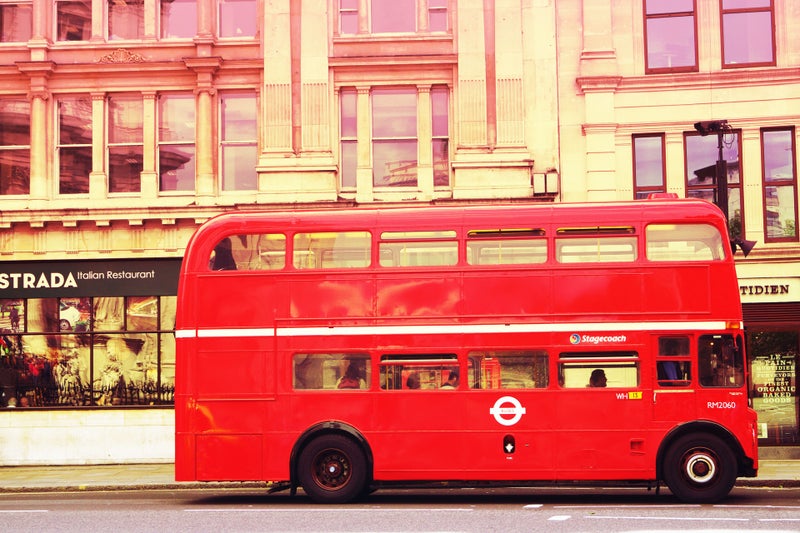
Buses from PARK LANE, KNIGHTSBRIDGE, PICCADILLY and DUKE OF WELLINGTON PL.

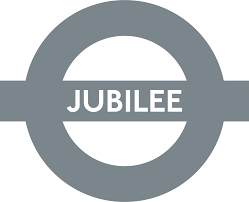

HYDE PARK CORNER and GREEN PARK LU STAs
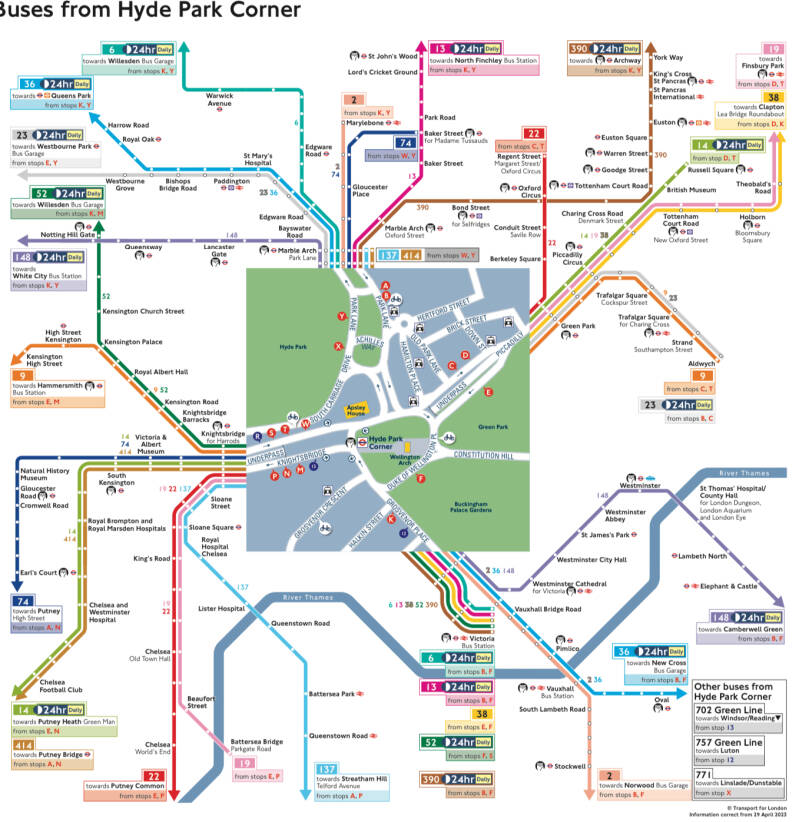
“NUMBER 1, LONDON”. APSLEY HOUSE
On the site of an old lodge and an older inn. Owned by the DUKE since 1817, it had been designed by ROBERT ADAM for BARON APSLEY., nearly 40 years before.
Adam’s building was a small, square, brick building. The arch. BENJAMIN D.WYATT transformed it. The Duke had, as well, virtually all Adam’s interiors stripped out.
The pedimented portico and the Piccadilly Drawing Rooms were added. Then, in 1828, a west extension was added, to house the PLATE AND CHINA ROOM, and the WATERLOO GALLERY above.
And, yes, the first house you would have encountered,beyond the TURNPIKE or TOLLGATE, at the beginning of the 19th c., when you were entering “LONDON” from the countryside. The property's official address today is 149 Piccadilly, Hyde Park Corner, London, W1J 7NT, but rumours still abound that if you posted a letter to 'Number 1, London' it would reach this address.
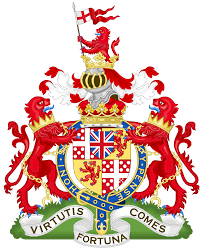
In the first and third quarters a cross argent (silver) with five plates in the quarters of the cross, in the second and fourth quarters a lion rampant gules (red) langued azure (with a blue tongue). As a result of his services to the United Kingdom the Duke was granted an 'augmentation of honour' - the union flag of the United Kingdom placed in the middle.
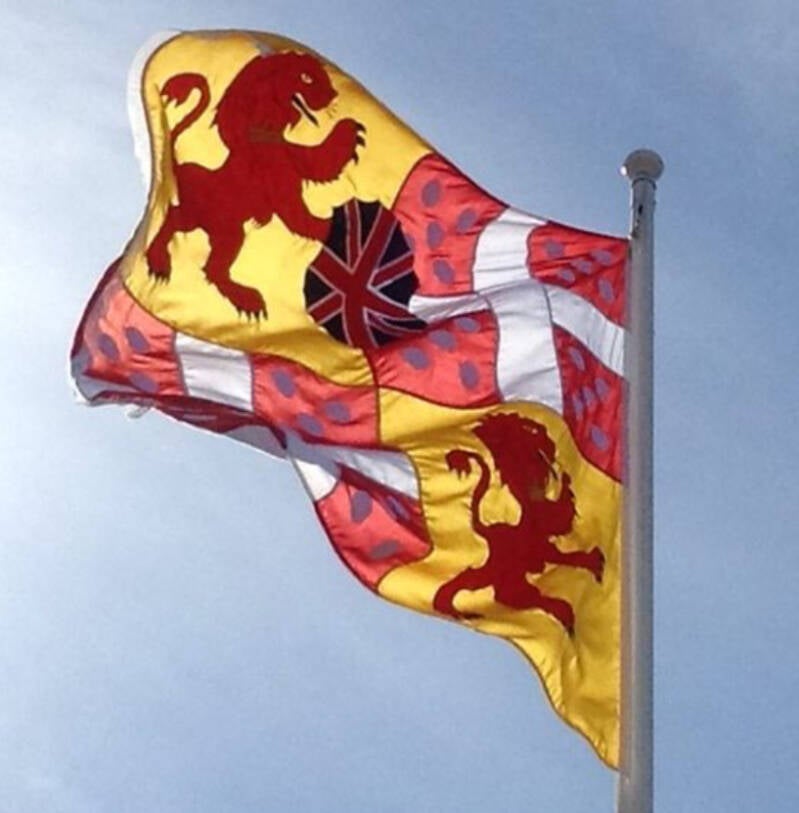
Given over to the nation in 1947 by the 7th Duke the house is still the home of the present Duke of Wellington and his family, while the historical collections are largely intact. The current Duke of Wellington (18th) is also the Prince of Waterloo and is styled 'His Serene Highness', a title granted by the Dutch king in 1815, which comes with the hereditary right to 2,600 acres of land in Belgium. He is also part of the Spanish nobility as the duke of Ciudad Rodrigo and the former Portuguese nobility as the duke of Victoria
Collection
PORCELAIN. As the House was used for entertaining on a grand scale, and Wellington's great dinner and dessert services are on display.
The Sèvres Egyptian Service was commissioned by Napoleon for his Empress Josephine, representing the monuments of the PHARAOHS.
GOLD and SILVER PLATE: The vast silver Portuguese Service, with an 8-metre-long centrepiece, adorned the table at the annual Waterloo Banquet, a great event at which the Duke entertained officers who had served with him at Waterloo and in the Peninsular War.
Orders of chivalry, commanding battons, snuff boxes
PAINTINGS formerly belonging to the Spanish ROYAL COLLECTION, which Joseph Bonaparte had previously stolen…
Chandelliers
Rooms devoted to the Duke: death mask, funeral Panorama, funeral program (printed in silk), cartoons (published after his death)
British paintings
Original ADAM decoration, conserved in the PICADILLY DRAWING ROOM and the PORTICO ROOM
God mars
A Carrara marble, colossal, STATUE OF NAPOLEON -11’ 4”, nude, by CANOVA. Wellington disliked the statue himself, and ended up in the hands of the PRINCE REGENT. ,
At Napoleon's personal and insistent demand, Canova had gone to Paris in 1802 to model a bust of him. When Napoleon saw it there in April 1811 he refused to accept it, calling it "too athletic" and banning the public from seeing it.
WATERLOO GALLERY. Dinning room where the early Waterloo Dinners were held by the participating generals
By the time he was premier (1829] a 90ft gallery was added, in a Louis Philippe style, as the guest list had grown
Charles I painting by VAN DYCK. Wellington by GOYA (originally a Joseph Bonaparte portrait, replaced by the final victor)
Murillo, Rubens, Reynolds, Bruegel, Mengs, Velazquez (Seville Waterseller, Spanish Gentleman). And Wellington’s favourite: CORREGE’S Garden’s Agony.
Battle of Waterloo, by Sir William ALLEN, in the STRIPED DRAWING ROOM.
A painting of George IV in kilt by WILKIE
Banquet table, with Portuguese service

On September 2, 1812, Francisco Goya exhibits an equestrian portrait of Wellington at the Real Academia de Bellas Artes de San Fernando in Madrid. Wellington had entered Madrid on August 12, 1812. This would mean that Goya had three weeks to complete the painting which experts seem to agree would not be enough time. In fact, x-ray examinations of the painting have determined that Goya adapted the painting from another painting that, in all likelihood, he had started earlier. Wellington's head is painted over the head of this other sitter. The original painting may have been a portrait of King Joseph Bonaparte, Napoleon's brother. The Wellington portrait is at the collection at Apsley House. Goya also painted another portrait of Wellington and did a haunting drawing of an exhausted Wellington after a battle. For more information on Regency Portraits see the following post.
THE WELLINGTON MONUMENT

The IRON DUKE mounted on COPENHAGEN, by sculptor BOEHM, guarded by a GRENADIER, a ROYAL HIGHLANDER, a WELSH FUSILIER and an INNISKILLEN DRAGOON, and cast from captured guns.
As for NAPOLEON’s horse, find out at the <<<NATIONAL ARMY MUSEUM<<<
City of london: Wellington statue and the BANK of england and the royal exchange

The equestrian statue of Arthur Wellesley, 1st Duke of Wellington located outside the Royal Exchange, now known as the Gallery of Modern Art, Glasgow, Scotland, is one of Glasgow's most iconic landmarks.
It was sculpted by Italian artist Carlo Marochetti and erected in 1844, thanks to public subscription to mark the successful end in 1815 of the long French Revolutionary Wars and the Napoleonic Wars. Since at least the 1980s it has been traditionally capped with a traffic cone by members of the public. The statue is a Category A listed sculpture.
WELLINGTON ARCH or CONSTITUTION ARCH

Built in 1825–7 and was originally intended as an outer entrance to Buckingham Palace. Palace, standing opposite and to the south of the SCREEN, in the middle of a perfect symmetrical composition (ST.GEORGE’S HOSPITAL -SCREEN- APSLEY HOUSE), that symmetry was destroyed, when moved here in 1883.
A solid construction, designed by DECIMUS BURTON, b.1825-28, to commemorate WELLINGTON’s victories over the French Armies, during the NAPOLEONIC
PEACE DESCENDING ON THE CHARIOT OF WAR
And, as well originally, it was surmounted by a colossal equestrian statue of the Duke. When the ARCH was moved to its present position, the statue was removed to the MILITARY ACADEMY, in ALDERSHOT. The current artwork was put in place in 1912, The spectacular bronze sculpture atop Wellington Arch, the biggest in Europe, is known as THE QUADRIGA. Crafted by Sir Richard Westmacott, the sculpture depicts the Angel of Peace descending on the Quadriga (four-horsed chariot) of War.


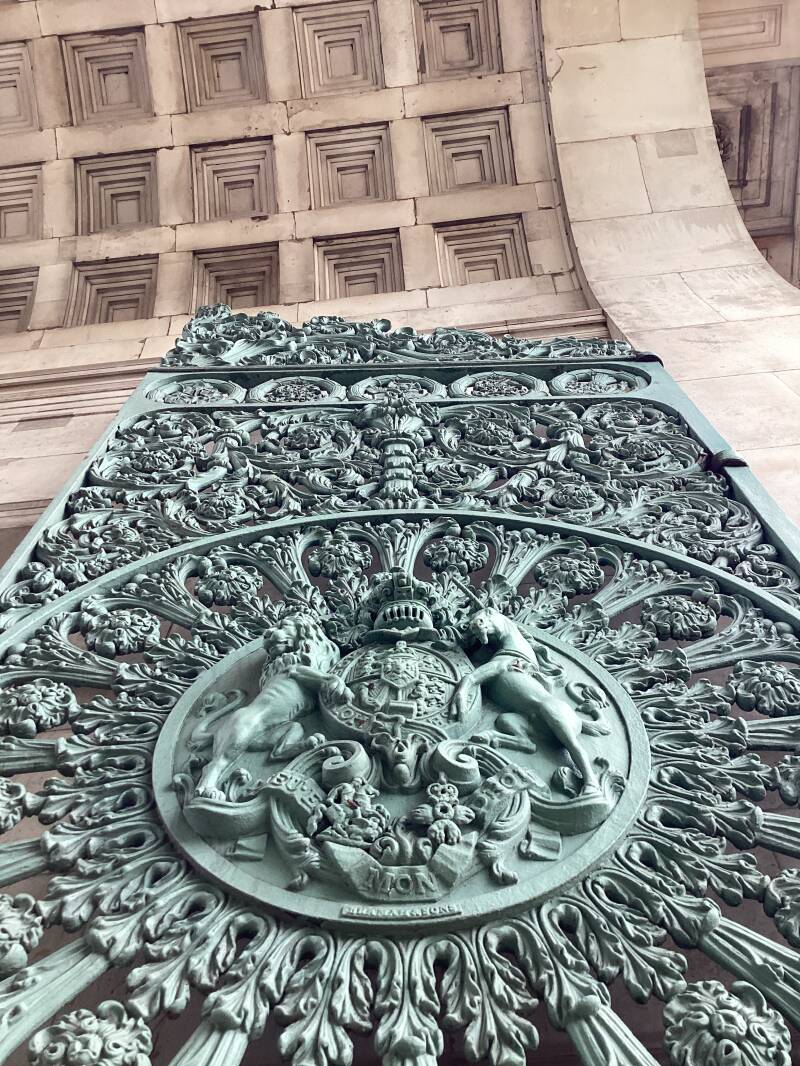

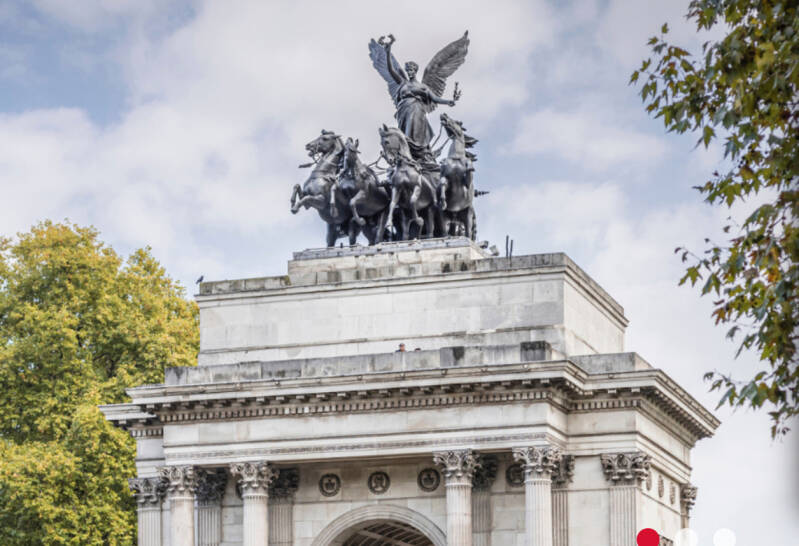
You can visit the interior of the arch (three floors of exhibits detailing the history of the arch, but, mind you!, half of the arch functions as a ventilation shaft for the Hyde Park Corner road underpass, constructed in 1961–1962… and you get good views of the surrounding area from the top!
Open to the public in 1992… before, it housed london’s smallest police station. really?
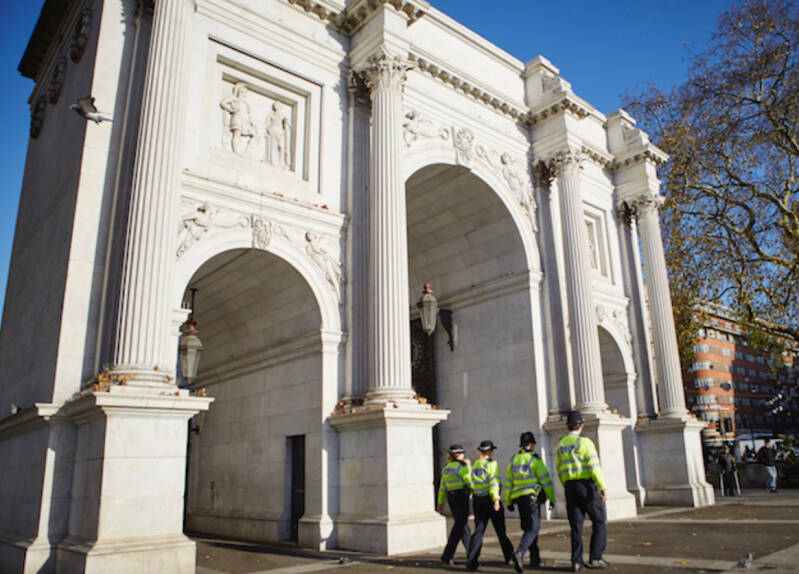
Was NOT Marble Arch Ever A Police Station?
The short answer is no but it was used by the Metropolitan police for over 50 years.
It was never a fully functioning police station, i.e. a place to report crimes, a building with holding cells or interview rooms. This myth may have grown out of confusing Marble Arch with the Wellington Arch at Hyde Park Corner, which did house a working police station until the late 1950s.
What about this one?. Nope
Not officially a POLICE STATION!. Only a LOOKOUT post

originally here, but…
Now in HAMPSHIRE
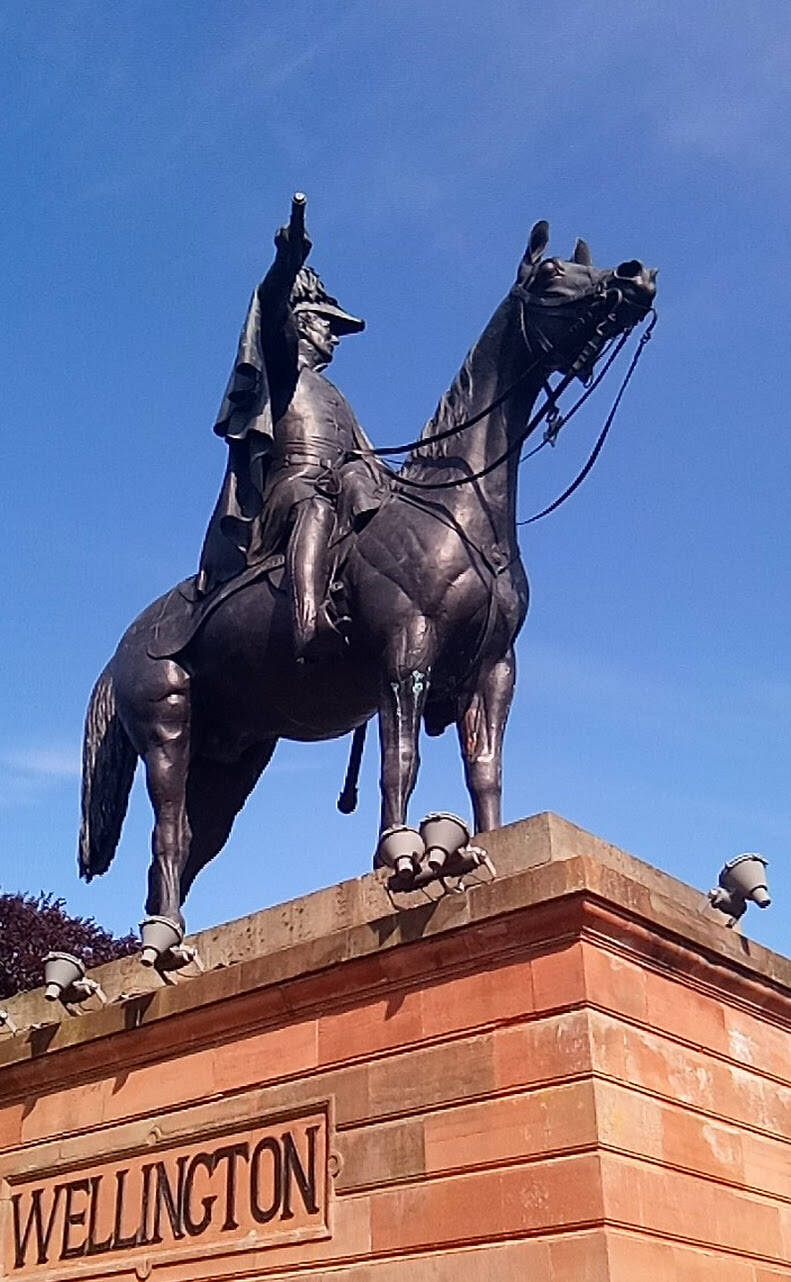
The origins of the statue go back to the end of the Napoleonic Wars, when various memorials to the British triumphs were begun, including Nelson's Column in Trafalgar Square and the victory arch at Hyde Park Corner. In 1837 a committee was formed under the Chairmanship of the Duke of Rutland to raise funds for a military memorial to the Duke of Wellington. The sculptor was Matthew Cotes WYATT, a highly controversial choice at the time. The monument was made on a massive scale, the largest equestrian statue hitherto seen in Britain. The final statue was 30 feet high, 26 feet from nose to tail, and 21 feet in girth. It weighed 40 tons.
Wellington. Le duc de fer et les français

Au course de son existence (1769- 1852), ARTHUR WELLESLEY, le 1er DUC DE WELLINGTON, malgré les aléas de le politique, tissa maints liens avec les Français.
Né à DUBLIN, le même année que NAPOLEON BONAPARTE (qu’il ne rencontra jamais), il séjourne an an à ANGERS, en 1786, comme élève de l’ACADEMIE D’ÉQUITATION, reçu chez les DUCS DE PRASLIN et de BRISSAC, et il mène une vie joyeuse tout en perfectionnant son français.
En 1794 il devient le beau -frèce d'HYACNTHE-GABRIELLE ROLAND, Parisienne très lancée, que RICHARD, son frère aîné épouse après 9 ens de vie commune et la naissance de 5 enfants (l'une des filles est au nombre des aïeux de l’actuel souverain).
En 1805 après un sejour de 4 ans aux Indes il épouse CATHERINE PAKENHAM, fille du BARON LONGFORD.
il rencontre aux eaux de CHELTENHAM une aimable émigrée , la ViCOMTESSE DE GONTANT-BIROB, et engage avec le GÉNÉRAL DUMOURIEZ une correspondance qui se prolongera jusqu’à la mort du vainqueur de VALMY, en 1823
Il Combat en Espagne pendant la Guerre d’INDEPENDANCE (1798- 1813) et en FRANCE jusqu’a l’abdication de NAPOLEON en 1814.
Il reçoit le titre de DUC et part à PARiS comme Ambassadeur d’Angleterre.
Sous le PREMIÈRE RESTAURATION il est en très bons termes avec LOUIS XVIII qui songe a le nommer MARÉCHAL DE FRANCE,avec le tite de DUC DE BRUNOY.
De son cotê il offre au roi podagre, qui n'en peut mais. une meute de chiens de chesse et achète à la PRINCESSE PAULINE BORGHESE l’HOTEL FAUBOURG ST HONORÉ, aujourd’hui encore le siège de l’AMBASSADE de GB.
Il fait a court a le Cerine HORTENSIE, va chez TALLEYRAND, noue des intragues avec une chanteuse, la GRASSiNi , et une artiste,, MARIÉ -
ViCTOIRE JAQUOTOT..
Aprés WATERLOS, le DUC DE FER , comme on va le surnommer, revint a PARiS en tent que commandant en chef des tropes d’occupation. Son quartier général esta MONT-SAINT-MARTIN , près de CAMBRAI, mais il habite souvent, place de la CONCORDE, HOTEL DE LA REYNiÈRE, à emplacement de l' actuelle ambassude des ETATS-UNiS.
Sa Gâce fréquente les salons de MME RECAMIERet de la DUCHESSE DE DURAS, courtise MLLE. MARS, et sympathise avec le DUC DE RICHELiEU.
En 1830, a Londres, le noble duc alors PM , entretiendra des rapports chaleureux, presque eaffectueux TALLEYRAND, que LOUIS-PHiLiPPE envoie comme ambassadeur
De même , c’est avec une cordiale sympathie qu’il, accueille en 1837, lors de couronnement de VICTORiA, son vieil adversaire d' ESPAGNE, de TOLOUSE et de WATERLOO, le MARECHAL SOULT
Totefois , quand on lui demande de lever son verre à l’armée Française, il grommelle entre ses dents: « l’armée Française , by God, ma besogne est de le battre, pas de boire à sa santé ». Puis, boit, quend même…
A sq mort, survenue à 83, des funérailles grandioses eurent lieu à ST.PAUL. Et son corps repose dans la crypte de la Cathédrale où l'on pouvait naguère voir le somptueux char funèbre qui mènera sa dépouille
LES FUNÉRAILLES DU DUC DE FER
Aprés les obsèques de NELSON, en 1805, ST. PAUL tut le théâtre de sobre apparat des cérémonies organisées en l’honneur de
WELLiNGTON
Dans le brume froide de ce mois de décembre 1852, précédé par les HALLEBARDIERS de la Tour, l’énorme char funèbre tirée par 12 chevaux noirs, était suivi du cheval d’armes du défunt, puis de son bâton de maréchal et de ses décorations.
Ensuite venaient la cour, les parents et amis du duc, en longues théories, huit escadrons de chevalerie,et trois batteries fermaient
la marche. A l’entrée de la Cathédrale, l'attendaient le clergé et le corps diplomatique au premier rang, duquel un sosie de Napoleon attirait tous les regards : il était WALEWSKY, le fils de l’mpereur, et de MARIE WALEWSKA, alors ambassadeur de France.
WALEWSKY avait hésité longtemps à assister aux obsèques du fossoyeur de son père, hmais BRUNNOW, l’ambassadeur Russe, avait triamphé a ses réticences en lui disant: "Mon cher. si cette cérémonie était destinée à a ressusciter le duc, je comprendrais vôtre répugnance, mais comme il ne s’agit que dé l'enterrer, je ne vois pas de quoi vous pouvez vous plaindre.


Underpass and pedestrian tunnels

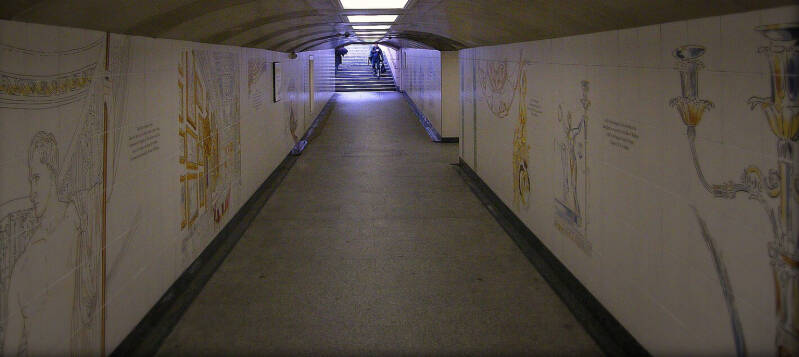
If you use these tunnels, you will find Interesting local history panels
Site of LANESBOROUGH HOUSE. Former ST.GEORGE’S HOSPITAL. Now LANESBOROUGH HOTEL

St George's Hospital was established at Hyde Park Corner in 1733. From the early days, surgeons and physicians were permitted to take on pupils. The first student records date from 1752, although the medical school itself wasn’t formally established until 1834.
John Hunter, often referred to as the 'founder of scientific surgery', was a student and surgeon at St George's. His legacy is nowadays quite controversial - although his contributions to medicine and anatomy are impressive, his methods in acquiring specimens were often cruel.
Former lu station
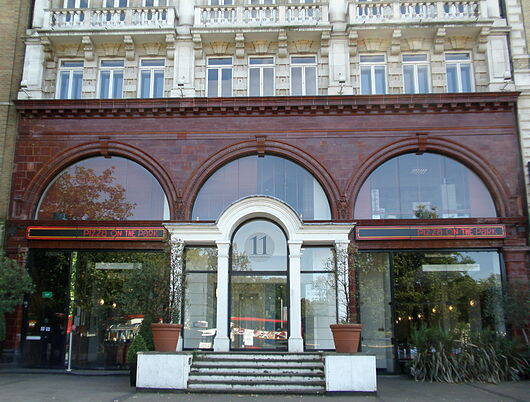
Pizza express
SITE OF TATTERSSALLS, HORSE AUCTIONEERS
Decimus burton’s screen

A triple arched screen crowned by a sculptured frieze (Sculptor JOHN HENNING Jr.). IONIC style.
Both SCREEN and ARCH were intended as a royal progress from the palace to the park.
Decimus?
Of course, he was the tenth child of the family!.
Burton's works are Hyde Park, London (including the gate or screen of Hyde Park Corner, the Wellington Arch, and the Gates); Green Parkand St James's Park; Regent's Park(including Cornwall Terrace, York Terrace, Clarence Terrace, Chester Terrace, and the villas of the Inner Circle which include his own mansion, The Holme, and the original Winfield House); the enclosure of the forecourt of Buckingham Palace from which he had Nash's Marble Archmoved; the clubhouse of the Athenaeum Club, London; Carlton House Terrace; Spring Gardens in St. James's; and the Palm House and the Temperate House at Kew Gardens. Burton designed the seaside towns of St Leonards-on-Sea, Fleetwood, and Folkestone, and also Royal Tunbridge Wells. His Calverley Estate (of which only a small proportion survives) was highly commended.
War MEMORIALS
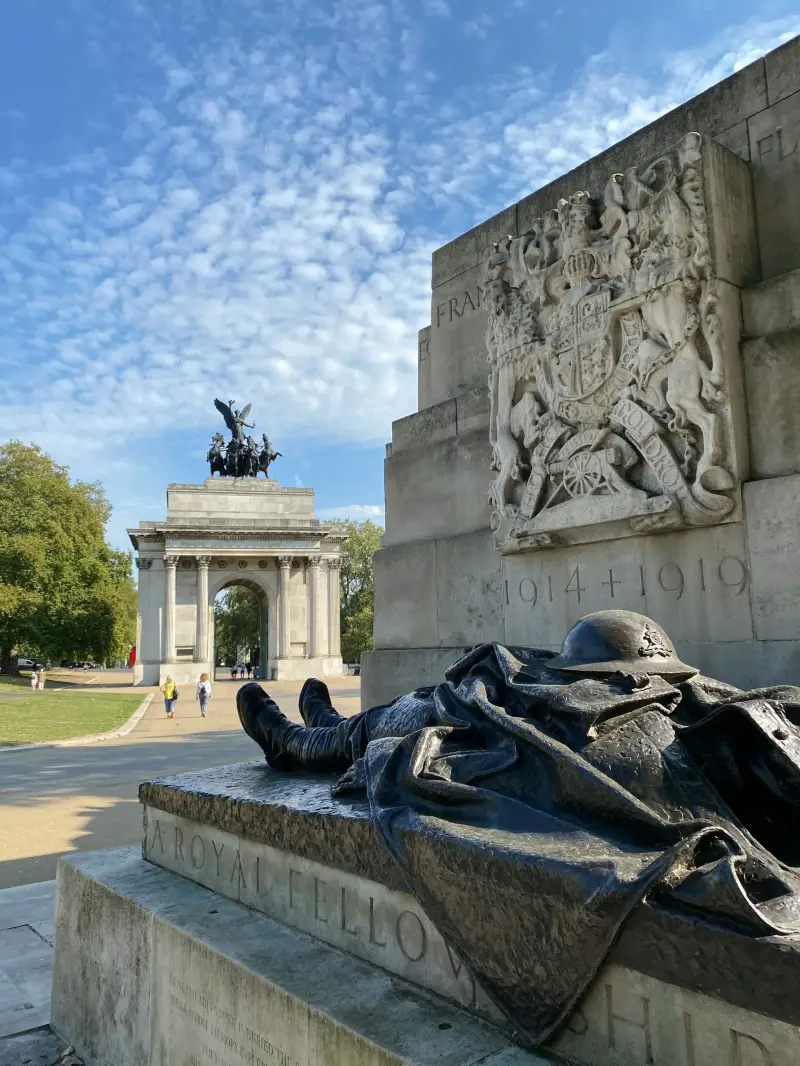
A large square pedestal with surmounting stone carved 9.2" Howitzer. The bronze figures of artillery men are featured on either side: a junior officer with a greatcoat and equipment at the front; an ammunition carrier facing east; and a cloaked driver facing west. The rear features the figure of a dead gunner shrouded in a cloak.
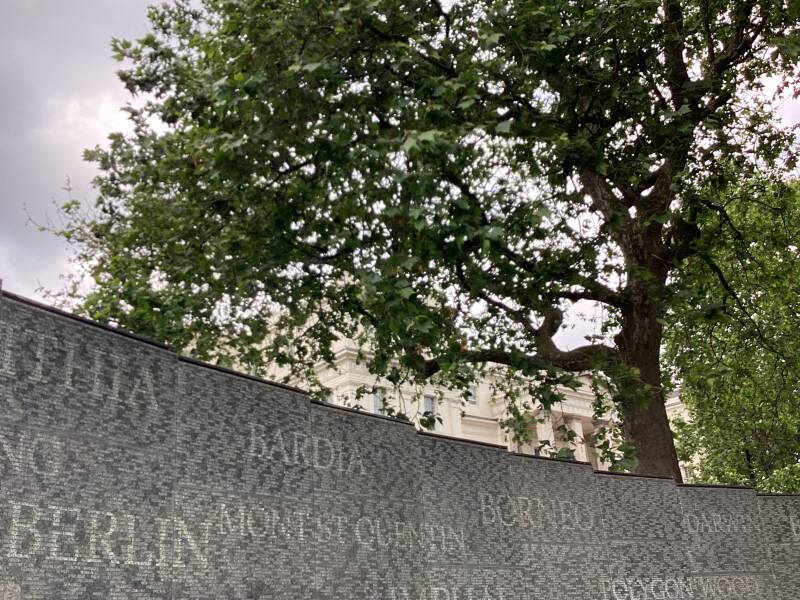
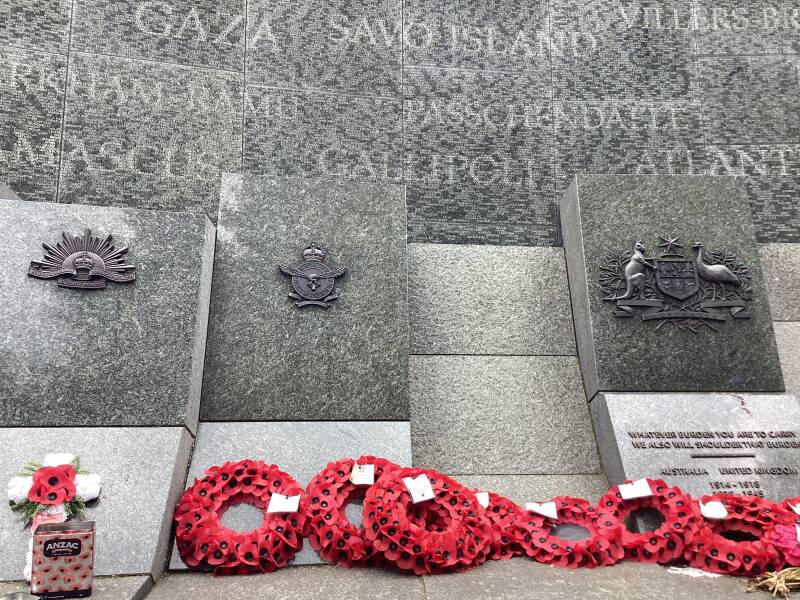
The granite stones are inscribed with the names of 23,844 towns in which the Australian soldiers were born, in Australia, the UK and elsewhere. Parts of some town names are picked out in bolder type, creating the names of 47 battles in which Australia was involved in a larger font.
The memorial comprises 16 bronze "standards" set out on a grassy slope at the east end of the Hyde Park Corner traffic island. Each standard is a cross-shaped metal girder 700 kilograms and set in a concrete foundation, with surrounds of British slate

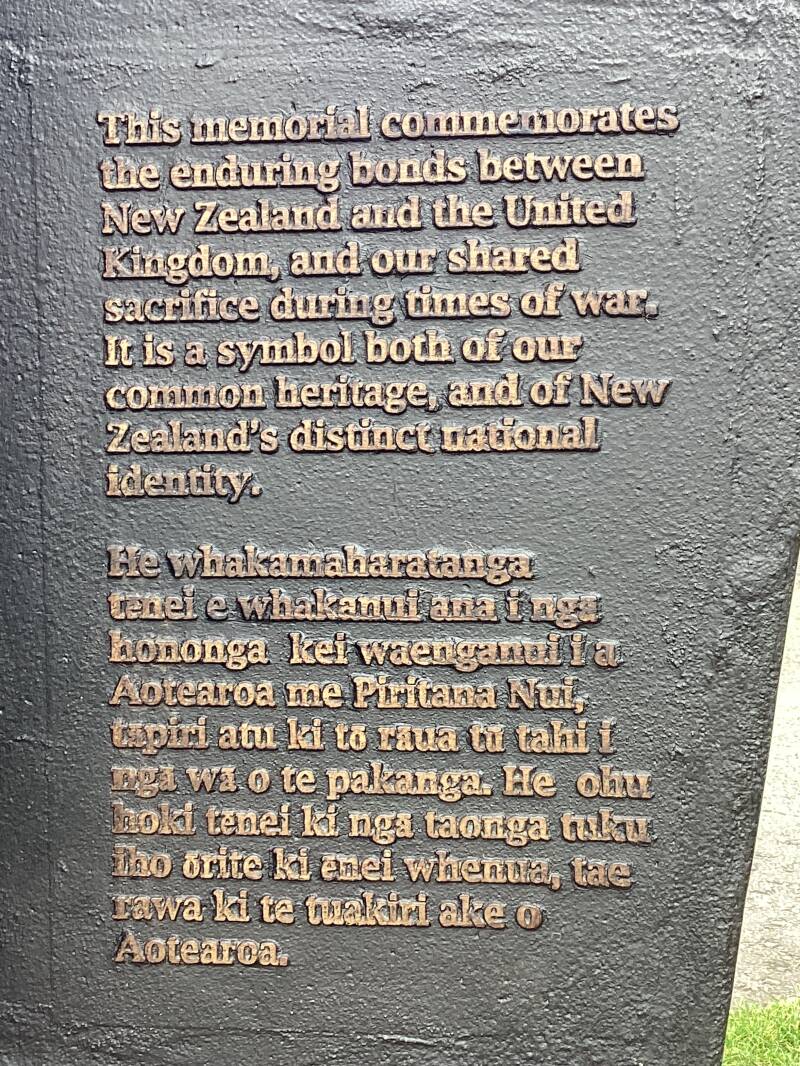


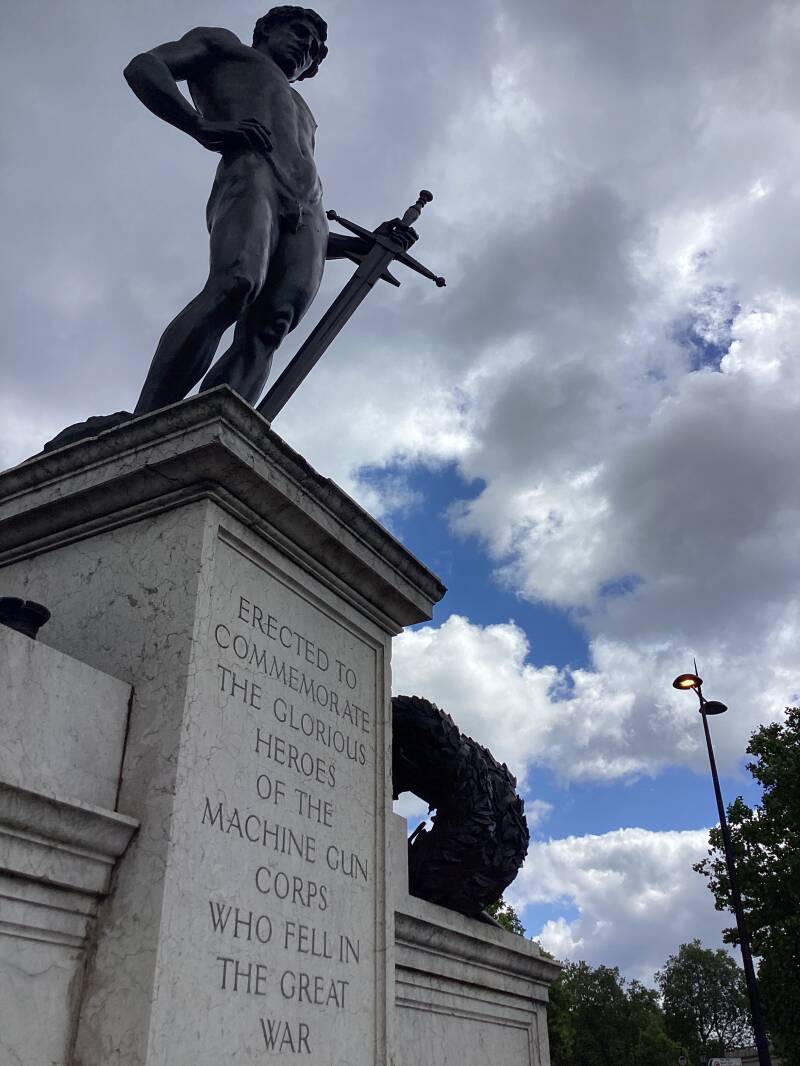

Former HIRAM MAXIM’S workshop in HATTON GARDEN, CLERKENWELL
First invented in 1884 by Hiram Maxim (1840-1916), the modern machine gun came into use in the late 19th Century in such conflicts as the Boer War and the Spanish American War. It saw use in many other places and became notorious for its use by European nations in their pursuit of colonies. The first combat use of the Maxim occurred on October 25, 1893 in modern-day Zimbabwe when 700 police troops of the British South Africa Company's Police (BSAP) were attacked by 3,500 Matabele warriors as British adventurers invaded their kingdom. Five Maxim guns killed about 1,500 warriors.

What you will find Alongside Piccadilly…
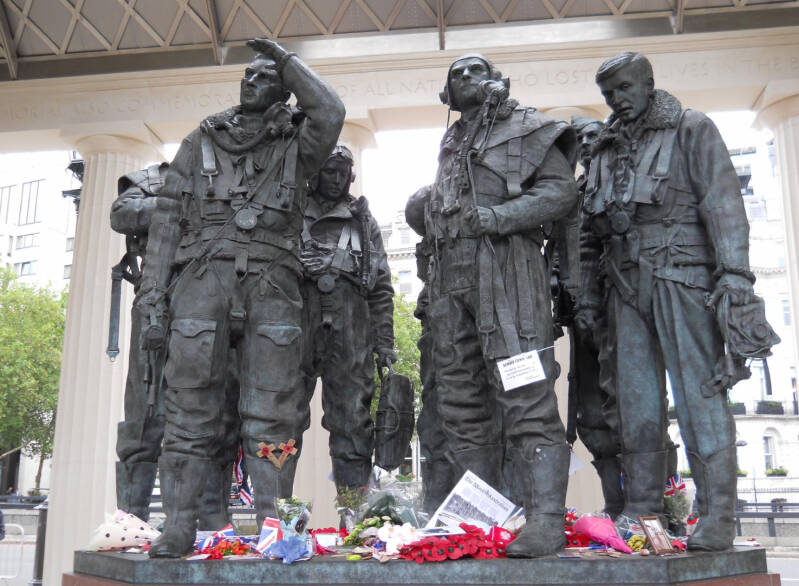
Liam O'Connor designed the memorial, built of Portland stone, which features a bronze 9 foot sculpture of seven aircrew, designed by the sculptor, Philip Jackson to look as though they have just returned from a bombing mission and left their aircraft

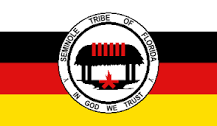
Who owns HARD ROCK CAFÉ?.
In March 2007, the Seminole Tribe of Florida acquired Hard Rock International, Inc. and other related entities from The Rank Group Plc. Today, Hard Rock International is one of the most globally recognized companies in the world and has venues in over 70 countries; Cafes, Casinos and Hotels.
the ritz hotel
In the late 19th century, Escoffier and Cesar Ritz launched together the Savoy, the Carlton and the Ritz hotels, the first modern luxury hotels in Europe, pioneering unprecedented standards of quality in service and elegant dining.
Escoffier is credited for elevating French Haute Cuisine to new heights, first in Britain, then around the world.
Having started his apprenticeship at the age of 12 and managed various restaurants in Paris and the French Riviera, Escoffier’s career took an unexpected turn in 1883. He was hired as Head Chef by Swiss hotelier César Ritz, then Managing Director of “Grand Hôtel” of Monte Carlo. It marked the beginning of an exceptional collaboration and friendship between the two men, who together would pioneer unprecedented standards of quality in service and elegant dining for the luxury hospitality industry.
Together they joined the newly opened “Savoy Hôtel” in London in 1890, the first luxury hotel in Britain. At the time, taverns were prevalent, and upscale restaurants were a fairly new concept. Escoffier aimed to introduce the English to the subtlety and delicacy of French haute cuisine.
Escoffier and Cesar Ritz then co-founded the Ritz hotel chain: they opened together the Ritz Paris in 1898, the Carlton Hotel in London in 1899, the “Grand Hôtel” in Rome followed, as well as the Ritz in New York and Montreal among others. Escoffier also managed kitchens for the new luxury ocean liners, such as the Hamburg-Amerika shipping line.
Escoffier is credited for making a la carte dining into a worldwide industry standard. At the Savoy, he was the first to offer an a la carte menu in Britain. He took great care when it came to composing a menu, which, he would say, was “first and foremost, a poem”. Soon enough, Buckingham Palace and British ‘High Society’ would adopt that form of service, which later spread worldwide, thanks in part to the Ritz hotels.

And In mayfair
Piccadilly. What is in a name?


The origin of a name: A piccadill or pickadill is a large broad collar of cut-work lace that became fashionable in the late 16th century and early 17th century.
A famous manufacturer of Piccadilly was ROBERT BARKER, who owned a huge manor with gardens on the area of modern SOHO. The property’s knickname was PICCADILLY HALL, which became corrupted…

You carry on the lbtc tour…
CONSTITUTION HILL (which constitution?).

Definitely, the UK possess a CONSTITUTION, a system of “constitutional” or fundamental, high ranked, basic laws, but not a WRITTEN “constitution” as is the word is normally understood, that is, a single text where the main principles of the political system are set in writing.
However, the “hill”’s name has thing to do with any constitution whatsoever. but was the setting for KING CHARLES II “constitutional walks” during his reign, from his residence in ST.JAMES’S PALACE.
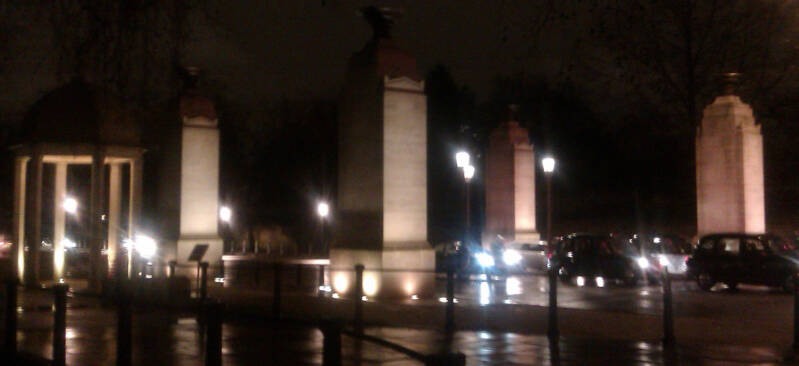
Soldiers from India, Pakistán, Bangladesh, Nepal, Caribbean countries and Africa are honoured here.
A set of 4 columns, 2 on either side of road, topped by an urn and also a circular, domed pavilion or Chattri with the names of those awarded the VC on its ceiling. Includes India Armed Forces Pakistani
High security walls?… BUCKINGHAM PALACE GARDENS

Traditionally used for Garden parties, in which the monarch honours charities and members of the civil society.
As well, the access forms partt of the visit to the State Rooms, in summer
Used by royals living in the palace?
Buckingham palace
Buckingham palace NORTH WING. QUEEN ELIZABETH HAD HER APPARTMENTS HERE...
The Palace is undergoing massive refurbishments, which started once QEII decided to live only in WINDSOR CASTLE for the reminder of her reign. That is the reason why KCIII does not live here since taking over… The works will continue for several years.
Other members of the Royal Family have lived in rooms on the upper floors of the NORTH and EAST sides.
BP also continues function as the official office of the King and others “working” members of the RF. Official engagements continue to take place.
And many members of staff do actually live in, to ensure the normal functioning of this “working” palace.
Who owns buckingham palace?
Occupied Royal Palaces, such as Buckingham Palace, are not the private property of the King. They are occupied by the Sovereign and held in trust by Crown Estates for future generations. But they are not managed by the THE CROWN ESTATE
The palace, like Windsor Castle, is owned by the reigning monarch in right of the Crown. Occupied royal palaces are not part of the Crown Estate, nor are they the monarch's personal property, like Sandringham House and Balmoral Castle.[69]
The Government of the United Kingdom is responsible for maintaining the palace in exchange for the profits made by the Crown Estate.
The crown estate
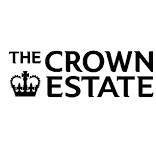
Established by an Act of Parliament in 1961, CE an independent, commercial business, managed by a Board (also known as The Crown Estate Commissioners).This independence is critical to enable the CE to fulfil ITS core duties, act commercially and deliver its strategy to create environmental, social and financial value both now and for the long term.
The Crown Estate is not the private property of the King. Its assets are hereditary possessions of the Sovereign held ‘in right of the Crown’. This means they belong to the Sovereign for the duration of their reign, but cannot be sold by them, nor do revenues from the assets belong to them.
The UK government does not own The Crown Estate either.

Crown Estate freehold in CENTRAL LONDON
Individual assets (buildings) owned by the c.e. In central london
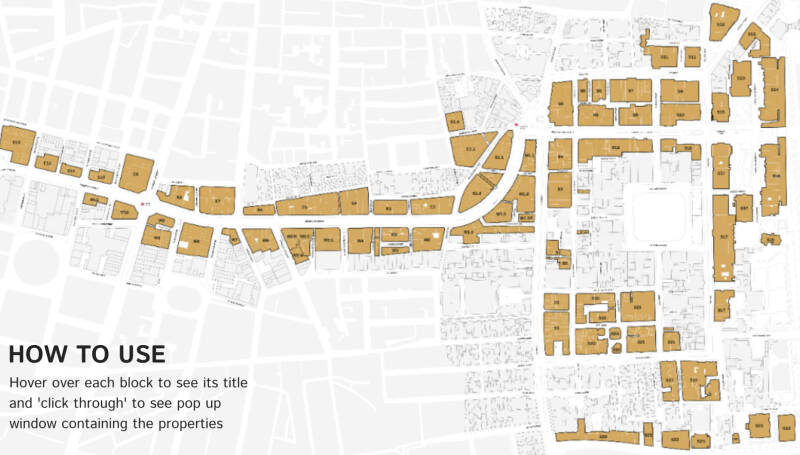
The Crown Estate is owned by the Monarch “in right of the Crown”. This means that while the King owns the estate during his reign, it is not his private property and he does not manage or make decisions about its assets.
This dates back to 1760 when George III surrendered the management of Crown Lands to Parliament for a fixed annual payment.
Later in the Crown Estate Act 1961 the modern-day independent and commercial organisation was created. Our profit is delivered to the Treasury, who then decide the annual payment to the King (the Sovereign Grant).
The Windsors’ private properties
The King privately owns two properties, Balmoral Castle and Sandringham House, which are not publicly funded.


what about highgrove house?

The property is owned by the Duchy of Cornwall and control of the House was transferred to William, Prince of Wales, when his father acceded to the throne and he became Duke of Cornwall on 8 September 2022.[3] The King rents the house from the Duchy to use as a country residence.[4
Properties of the DUCHY OF CORNWALL?
The Duchy of Cornwall is a private estate established by Edward III in 1337 to provide independence to his son and heir, Prince Edward.
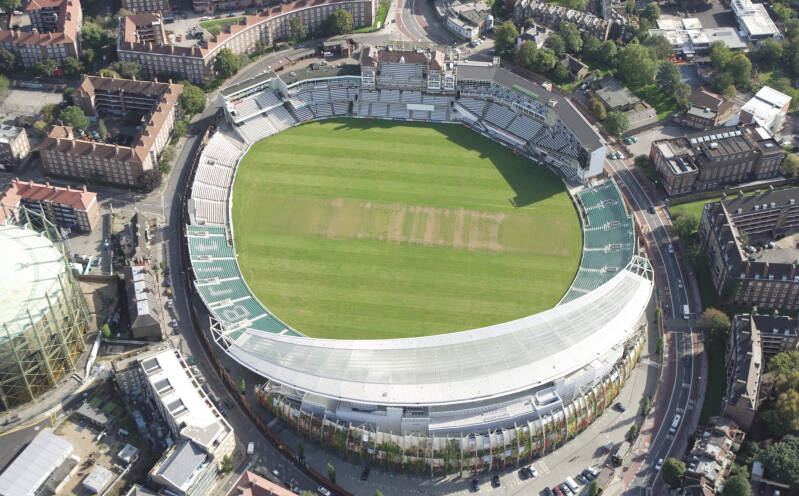
The Oval is a historical asset owned by the Duchy, and Surrey County Cricket Club became the sole leaseholder of the ground in 1874. Since then the Duchy has been involved with many improvements, from the rebuilding of the Pavilion in 1895 to 1897, right through to the new Pavilion portico completed in 2013
In 2005, the Duchy took the strategic decision to sell the retail property portfolio within its holdings. Currently the commercial portfolio consists of 18 properties and is valued at £124 million.
Discovered in the 1960s during the construction of the Victoria Line. Excavated bones dated back to the 17th century, suggesting that this was a plague pit.
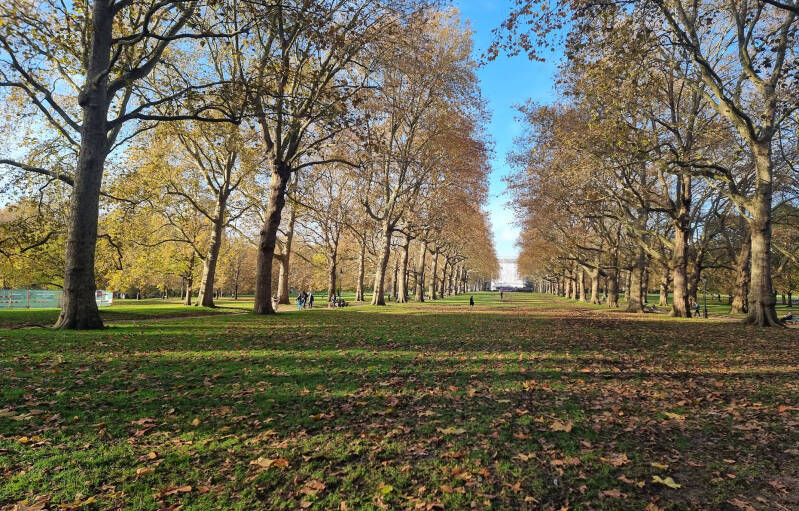
In contrast with its neighbouring parks, Green Park has no lakes, no buildings, no playgrounds and very few public monuments
The CANADA MEMORIAL
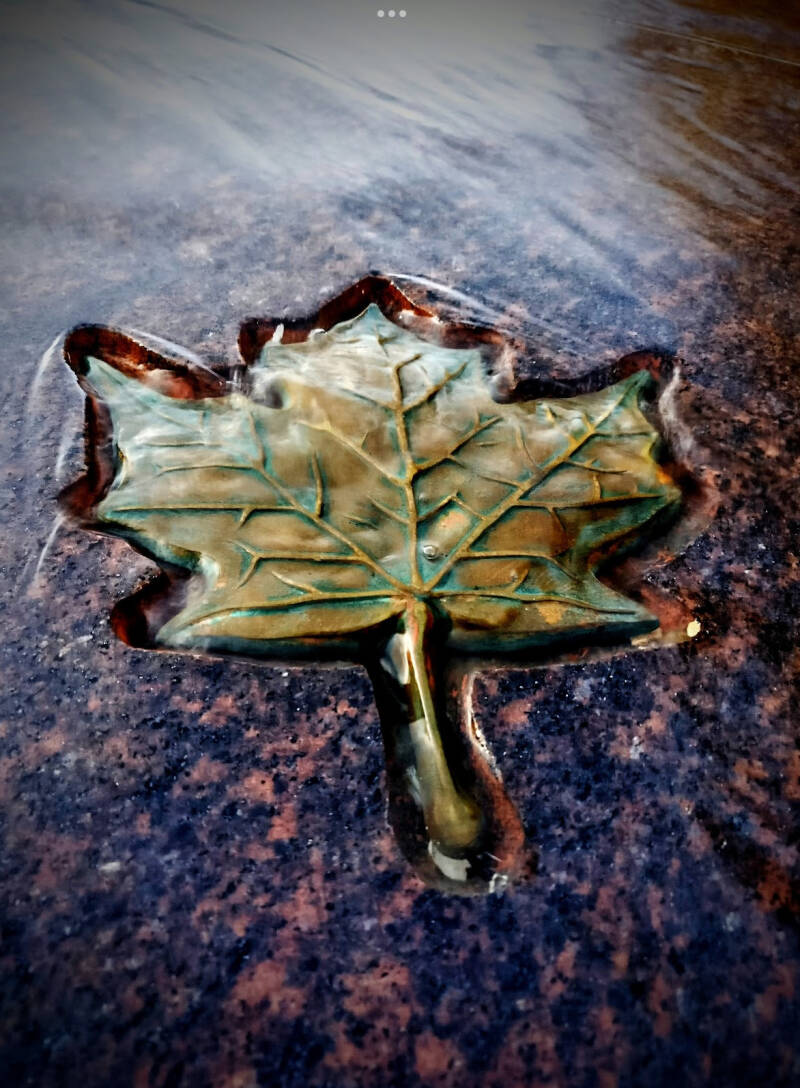
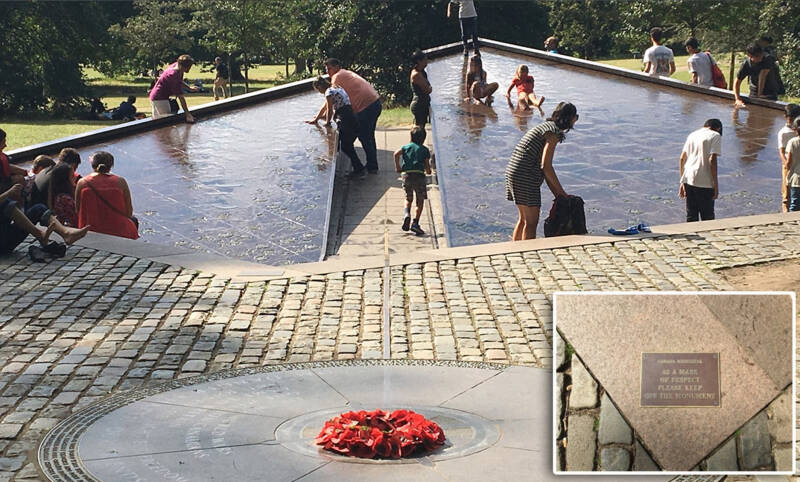
PIERRE GRANCHE
CANADA GATE

Canada Gate forms part of the Queen Victoria Memorial scheme in London. An entrance to the Green Park, one of the eight Royal Parks in central London, the gate was presented to London by Canada(then[when?] the senior Dominion of the British Empire) as part of a vast memorial scheme dedicated to Queen Victoria, who died in 1901.
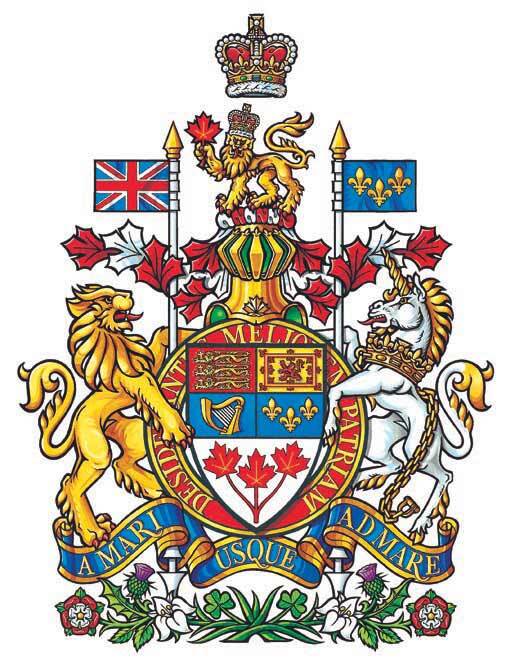
The sprig of three maple leaves represents all Canadians, the maple leaf having been used as a Canadian symbol since the early 19th century. The other four quarters (i.e., sections) of the shield are the royal emblems of the United Kingdom and France: the three lions of England, the lion within a double tressure of Scotland, the harp of Ireland and the fleurs-de-lis of France.
The ring around the shield bears the Latin motto of the Order of Canada, Desiderantes Meliorem Patriam, meaning “They desire a better country.” This follows a tradition whereby a nation’s shield is shown with part of the insignia of its senior national order.

Discover a bit more: On the picadilly (North) side of the park…
The Diana of the treetops fountain

By artist ESTCOURT J.CLACK. The statue was a gift of the Constance Fund, which had been established by artist Sigismund Goetze to gift sculptures to London parks in memory of his wife.[2] Sigismund pre-deceased his wife in 1939 and she administered the Constance Fund until her death in 1951, commissioning a number of sculptures in his memory.
Devonshire gate
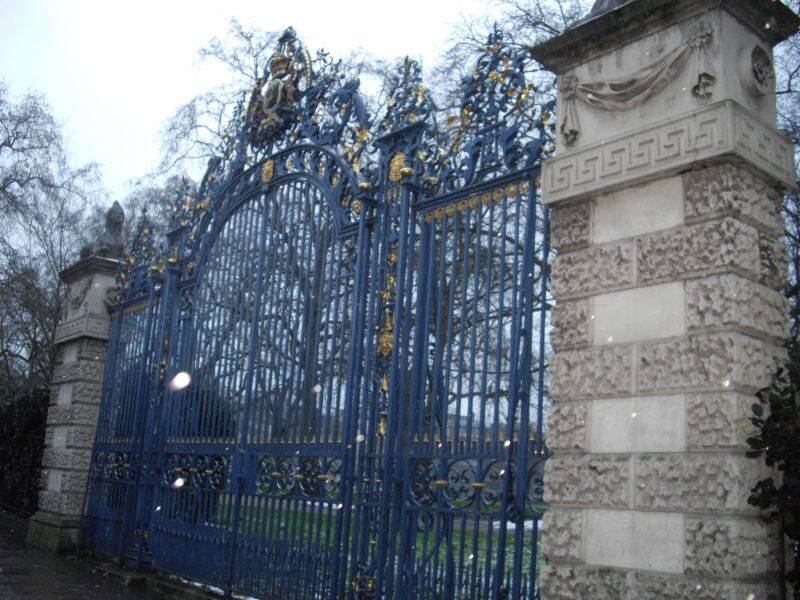
Cambridge house
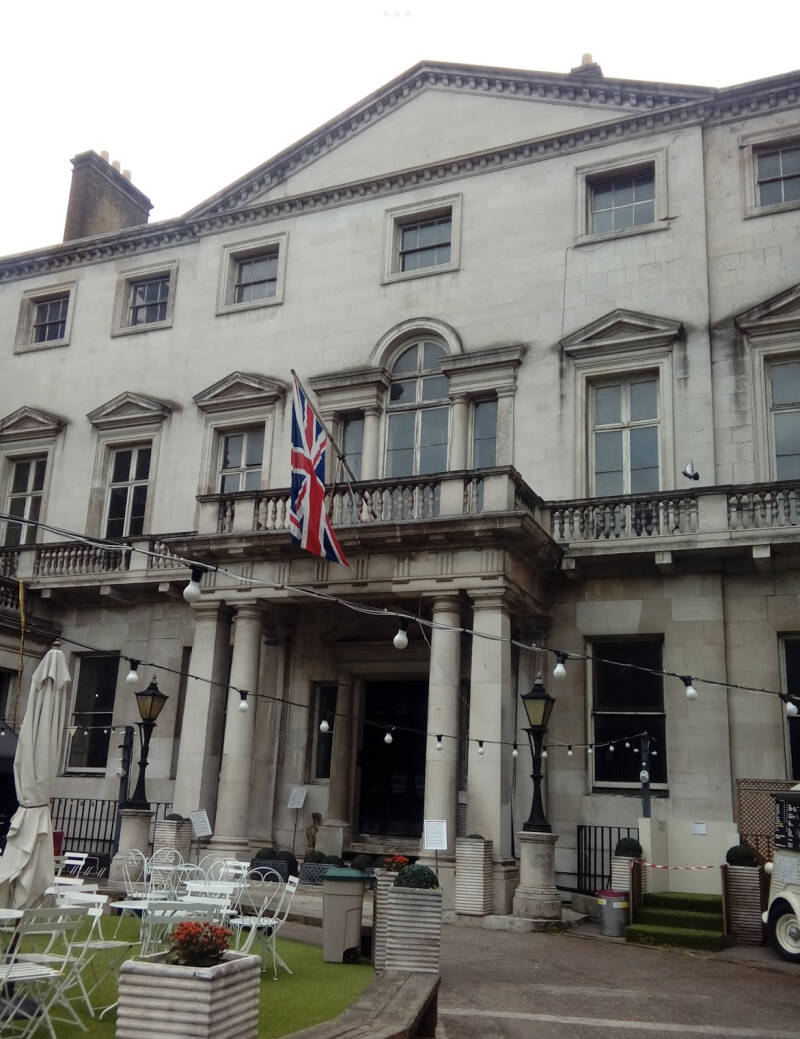
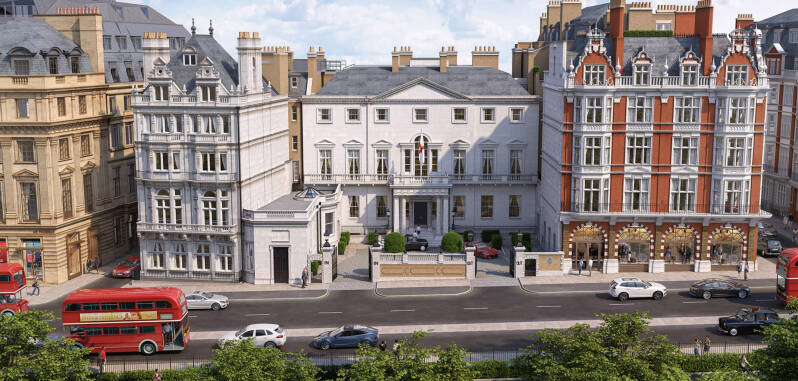
Cambridge House is a Grade I listed mansion on the northern side of Piccadilly (Number 94) in central London, named after one of its owners, the Duke of Cambridge, 7th son of George III. It has also been known as Egremont House, Cholmondeley House, The Naval and Military Club, and the In and Out Club.
The house was built for Charles Wyndham, 2nd Earl of Egremont, by architect Matthew Brettingham, a master who revolutionized the design of the grand town house, in the parish of St George Hanover Square from 1756-1761. Much of his principal work has been demolished, particularly his work in London. The house is one of the few great town houses still standing.
It was initially known as Egremont House. The house is in a late Palladian style. It has three main storeys plus basement and attics and is seven bays wide. As is usual in a London mansion of the period the first floor is the principal floor, containing a circuit of reception rooms. This floor has the highest ceilings and its status is emphasized externally by a Venetian window in the centre
The 2nd Earl of Egremont died as the house was near completion and the house was passed onto his twelve year old son, the 3rd Earl of Egremont, who occupied the property from 1764 to 1794.
The house changed hands several times. For several years in the 1820s it was occupied by George Cholmondeley, 1st Marquis of Cholmondeley and known as Cholmondeley House. From 1829 to 1850 it was the London residence of Prince Adolphus, Duke of Cambridge, and became known as Cambridge House. The Duke was born in Buckingham Palace, the 10th child of King George III. Due to his royal status, that name has persisted.
After the Duke died in 1850, the house was purchased by Lord Palmerston, who was Prime Minister of the United Kingdom for most of the decade from 1855 to 1865. He was the oldest man, ever, to become Prime Minister at the age of 70. It was his London residence and the site of many splendid social and political gatherings, dinners and parties. He walked to Westminster daily, from here. It was during Palmerston's time that the front boundary wall was given the two gates to allow carriages to enter the front drive and not block the road. After Palmerston's death at Brocket Hall in Hertfordshire in 1865, his body was taken to Cambridge House from which his funeral procession departed to Westminster Abbey.
In about 1808, it is interesting to note that Lord Palmerston began a relationship with Egremont's illegitimate daughter, Emily, who he eventually married. They had a happy marriage and produced 10 children.
Shortly after Palmerston's death, Cambridge House was purchased by the Naval and Military Club, which had outgrown its previous premises. The Club came to be known as the "In and Out", from the prominent signs on the entrance and exit gates of 94 Piccadilly. It was a private members club for officers and gentlemen of the British Armed forces. It was entirely refitted for the Club and was one of the most sumptuous and comfortable of London Club Houses. Members included lan Fleming, Rudyard
Kipling and T.E.Lawrence.
During World War 2, the building suffered damage. A bomb demolished two floors on the western half of the façade, requiring extensive renovations.
In 1999, the Club moved to new premises. They humorously put "In & Out" on the single main entrance of their current home at 4 St James Square. The Club sold Cambridge House in 1996 to entrepreneur Simon Halabi for £50 million. Halabi planned to convert the property into a private members club and hotel, part of his Mentmore Towers project, and to build a swimming pool and squash courts underneath the forecourt of the house. However, the building remained vacant after 1999, and fell into a state of disrepair. Plaster was falling off the ceiling in the first floor rooms, and many floorboards had been pulled up.
In 2009 Halabi's companies went into bankruptcy. In June 2010 Cambridge House and its adjoining buildings, 90-93 Piccadilly (and 42 Half Moon Street), 95 Piccadilly (the former American Club) and 12 White Horse Street (rear section being vacant land), as well as 96-100 Piccadilly (on the other side of White Horse Street) were ail offered for sale through property brokers Jones Lang Lasalle, collectively referred to as the Piccadilly Estate. In June 2011 the site was acquired by the Reuben brothers through their investment company, Aldersgate. In October 2012 applications were submitted for a full refurbishment into private homes
In April 2013, David and Simon Reuben won approval to develop the property as a 60,600 square foot residence.
Whilst the owners explore other redevelopment options they have graciously allowed us the use of the

Again, on the lbtc route. You are in front of…
The famous balcony…
buckingham palace, east wing







Not so well known aspects of buckingham palace and royalty…
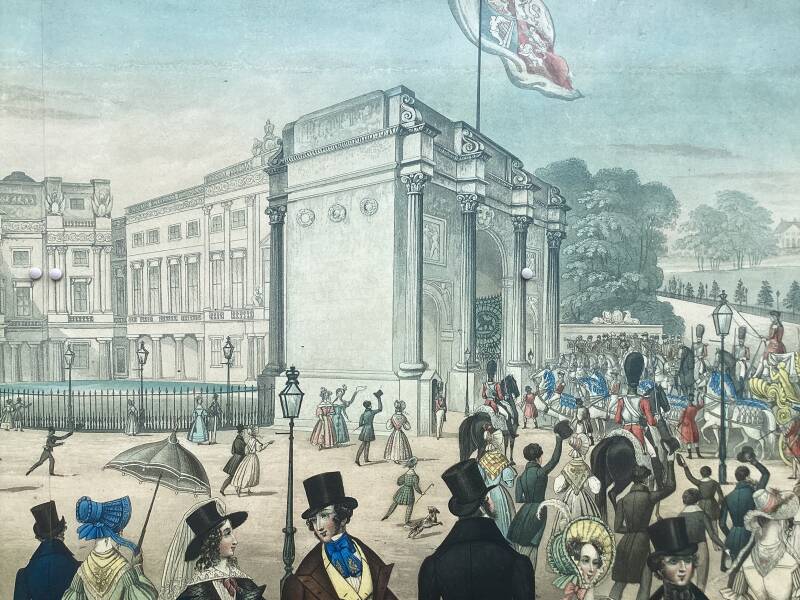

A MARBLE ARCH at the front of the palace?
Among the 775 rooms are 19 grand State Rooms for events, 52 Royal and guest bedrooms, 78 bathrooms, 188 staff bedrooms, and 92 offices for the King, Royal Family, and staff.
Of the State Rooms, the Throne Room is for ceremonial and official events - and the Prince and Princess of Wales took their wedding photos there. Most opulent is the White Room, where the King receives guests.
Over 800 people work for the Royal Household, and a lucky few do live in suitably posh apartments (which are said to be lovely, but obviously not as grand as their royal bosses'). There are also staff quarters for a range of household workers, some of whom might live there too.
Edward jones enters the palace…
As a kid, little Edward Jones was pretty fascinated by the Royal Family. So much so that he managed to sneak into the residence three times. Well, at the very least he was caught three times.
He managed to steal Queen Victoria's underwear (!), as well as food from the kitchens. He even boasted to the press that he'd sat on her throne.
A more recent intruder
Everyone has heard about the man who had a cig with QuEEN ELIZABETH II…
SIR JOHN WILLIAMS, QV’s SURGEON
queen victoria and jack the ripper. WAS JACK THE RIPPER A MEMBER OF THE ROYAL FAMILY
There is a claim, a theory, according to which a Jack the Ripper was a royal. RICHARD JONES, an expert, writer and guide, says:
“The Royal in question is, or was, Prince Albert Edward Victor, the Duke of Clarence and the heir presumptive to the throne of England. Now, I should say – with a thousand apologies to those who are convinced that the Whitechapel murderer was a deranged member of the Monarchy – there is no proof whatsoever, other than wishful thinking and wild speculation, to link Jack the Ripper with the Royal family”.
STEPHEN KNIGHT presented an elaborate conspiracy theory involving the British royal family, freemasonry and the painter Walter Sickert. He concluded that the victims were murdered to cover up a secret marriage between the second-in-line to the throne, Prince Albert Victor, Duke of Clarence and Avondale, and Annie Elizabeth Crook, a working class girl.

SIR WILLIAM GULL

There is another version of this claim: i that Jack the Ripper was a Royal surgeon who murdered the prostitutes to conceal that shameful Royal secret, at Queen Victoria’s request.
Sir john WILLIAMS

In the book Uncle Jack, author Tony Williams, and co-author Humphrey Price, present to us an entirely new Ripper suspect in the form of the eminent Victorian doctor Sir John Williams. WILLIAMS (a descendant of the prestigious surgeon) states that Sir John might have been driven to commit murder in the name of medical research, because his wife could not have children.
Letter from Queen Elizabeth to Queen Mary describing the bombing of Buckingham Palace
Buckingham Palace was bombed nine times during the course of the Second World War. The raids caused considerable damage to the Chapel and resulted in the destruction of the Northern Lodge, where a policeman was killed by flying debris. In August 1944, a V1 rocket, or ‘flying bomb’, landed in the grounds of the palace, shattering windows and destroying trees. King George VI and Queen Mary had been present in Buckingham Palace during a number of these air raids, including the one described so vividly in this letter at the height of the Blitz. The King wrote to Queen Mary the next day, adding, ‘The aircraft was seen flying along the Mall before dropping the bombs … It was most certainly a direct attack on B.P. to demolish it.’
So secret, so secret… that it might not exist.
secret tube station (to evacuate the royal family in case of war)

The Victoria Line of the London Underground runs more or less directly under Buckingham Palace, but there is no station there, nor has there ever been one.
The station to the north of the Palace is Green Park; that to the south is Victoria. This section of line opened in 1969 and has always been very busy. The tunnels on this line are 12 feet in diameter and do not widen at any point between Green Park and the crossover immediately to the north of Victoria (which can be confirmed by any passenger who looks out of the window during the journey).
It therefore follows from the above that there can be no secret station on this line under the Palace. Nor can there be a separate branch secretly running off this line. Even if this hypothetical branch were ‘hidden’ by some sliding door fitted flush with the tunnel wall, the branch would have to be connected by pointwork (a.k.a. trackwork) with the Victoria Line. Trains travelling over the points make a distinctive sound that is quite unmistakable to experienced travellers (and these points could actually be seen by the train drivers)!
THE “WEDDING CAKE”, QUEEN VICTORIA MEMORIAL
Do not get confused, this is a VICTORIA SPONGE!


Wedding cake?
Australia gate

Photograph showing the new facade of Buckingham Palace, completed in 1914, with the Australia Gate adjacent to the palace, with a sculpture of a cherub holding a kangaroo. The Australia Gate was part of the Queen Victoria Memorial and gardens designed by Aston Webb and the arts and crafts Bromgrove Guild made the iron gates. One of 8 images on album page (album: 2303705).


Buckingham palace south wing (alongside buckingham palace road)
The king’s gallery, royal art collection
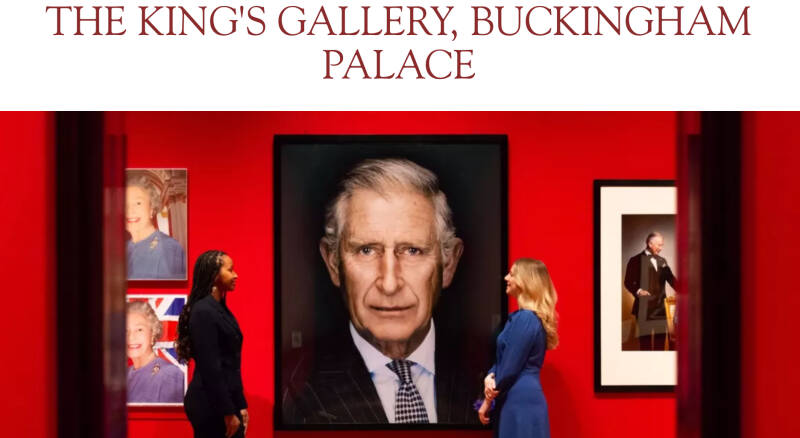
The King's Gallery, the Queen's Gallery during the life of EII, is a public art gallery, frst opened to the public ipin 1962. It exhibits works of art from the Royal Collection on a rotating basis. Enlarged in the early 21st century, the gallery has its own separate public access entrance built in a 'new' classical style and typically displays about 450 works, mainly paintings and drawings.
Talking about the royal art collection… what a mention of a famous soviet spy?
Anthony blunt

which take us to hampstead (and to agatha christiE, WHO ONLY WROTE ONE SPY NOVEL)

Now, seriously, when in london, do not miss hampstead!
The ROYAL MEWS

The institution goes back much further, to the King's Mews in the reign of Richard II in the late 14th century. For around 100 years until the reign of Henry VII, the King's Mews was at Charing Cross on the present site of the National Gallery in London.
Mews… this is a very london type of street!
A mews has an equine heritage. They served as stables and accommodation for those employed in the transport means af the wealthy families. Mews roads originally serviced the main properties they were connected to. The mews are generally not accessed from the principal roads but from secondary roads or through gaps between buildings. The rear elevations of the larger scale buildings often dominate the smaller mews properties. Mews fill the available space and are shaped in accordance with the landownership within the block.
And a vEry french word… FRENCH AGAIN?
The name 'Mews' comes from the that the royal HAWKS were originally kept at the KING’S MEWS. The word 'mew' means moulting, and the birds were kept in a 'mews' as they weren’t used for hunting whilst their feathers moulted. MOULTING and MOULTED are words derived from the French verb MOUER (to moullt) and MOUAGE (moulting). The actual buildings were destroyed in a fire during the reign of Henry VIII in 1534 and rebuilt as STABLES but kept the name 'Mews' even though it had a different function.
Want to visit a secret gem?. Victoria square


A young diminutive QV in diminutive square.
You are getting close to VICTORIA STATION. Queen Victoria is everywhere…

One of London’s great termini. It was first referred to as the ‘Grosvenor Terminus’ as it was built on the site of old Grosvenor Canal basin. It was eventually named after nearby Victoria Street, rather than Queen Victoria.

LU VICTORIA LINE is one of the the ones serving the railway station
By the way…
Queen Victoria was the first monarch to travel by train, when on 13 June 1842, she boarded the Great Western Railway train at Slough Station. The train was pulled by the engine Phlegethon, and the trip to Paddington Station took 25 minutes. In the cab rode Isambard Kingdom Brunel, the famous engineer and designer of Paddington Station. The Queen enjoyed her ride and wrote in her diary that it was 'delightful and so quick.'



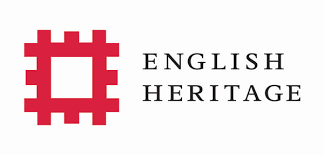
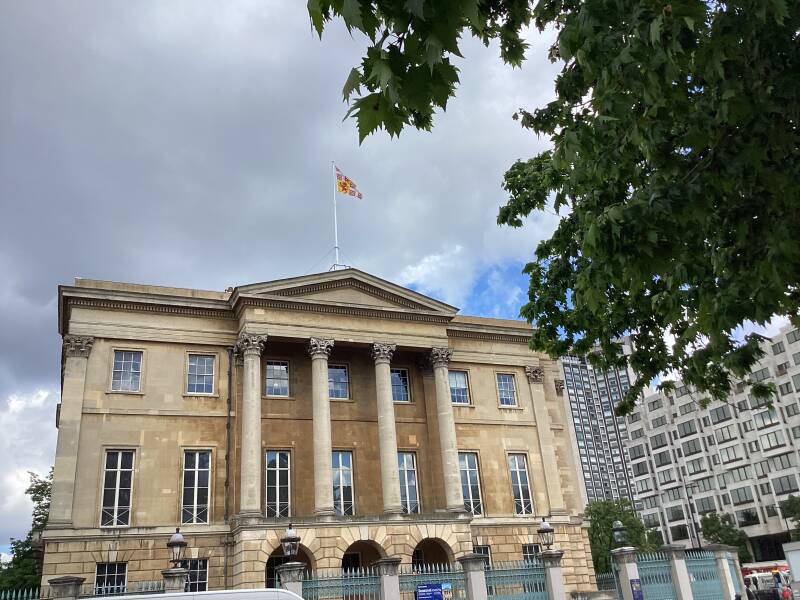
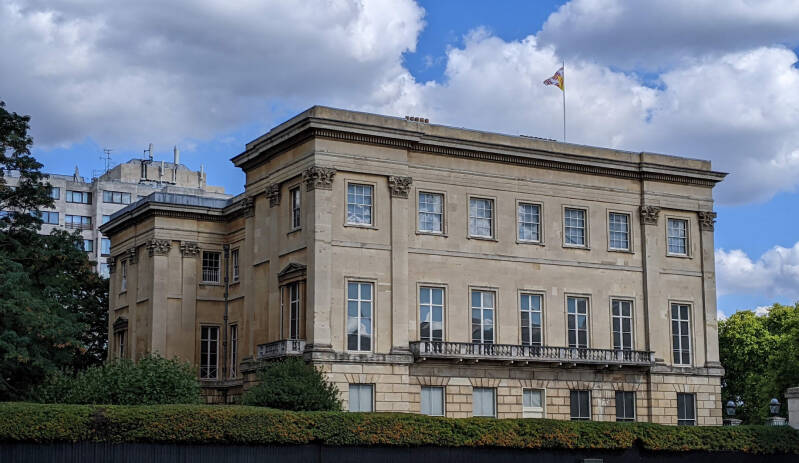
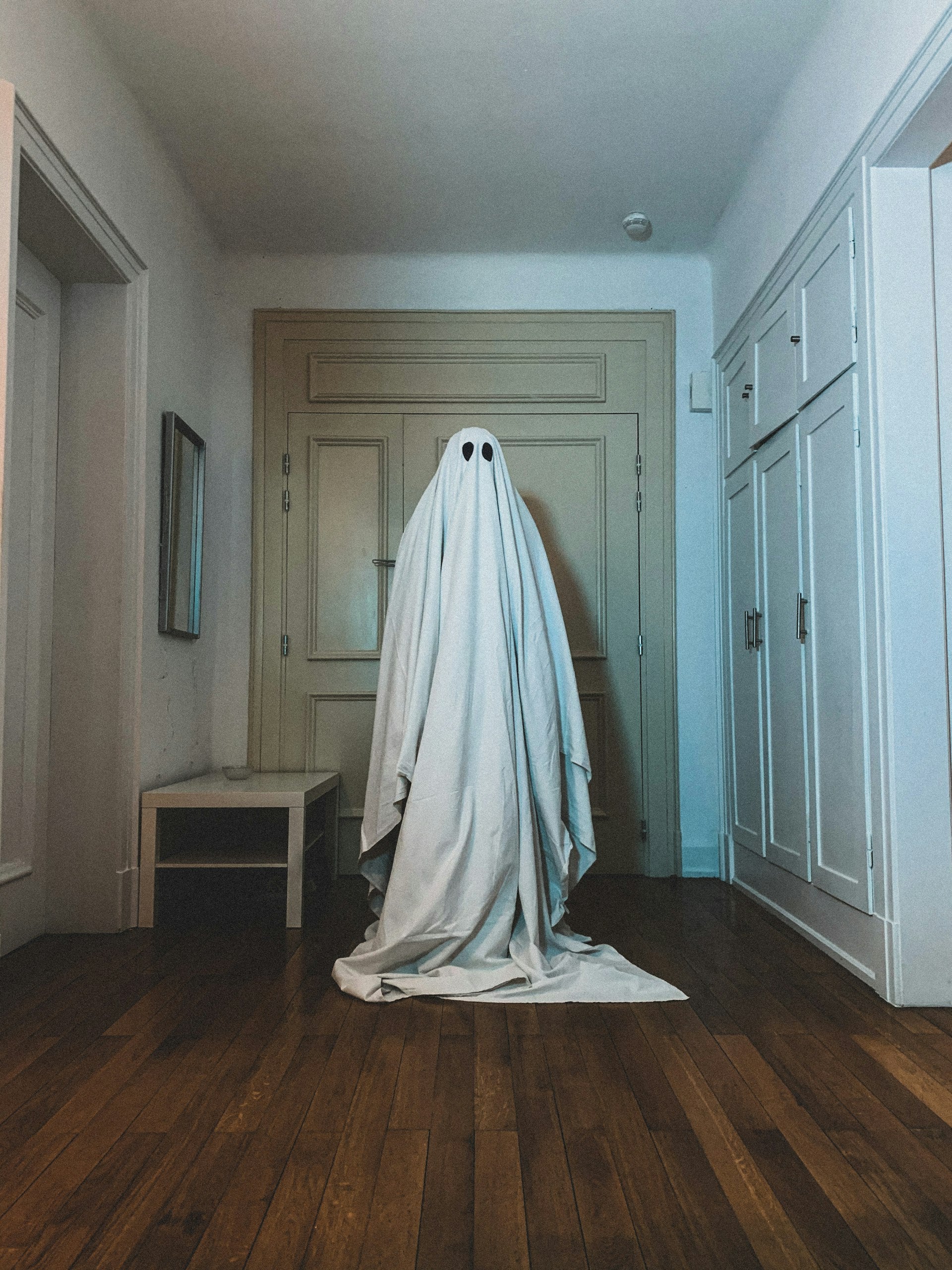


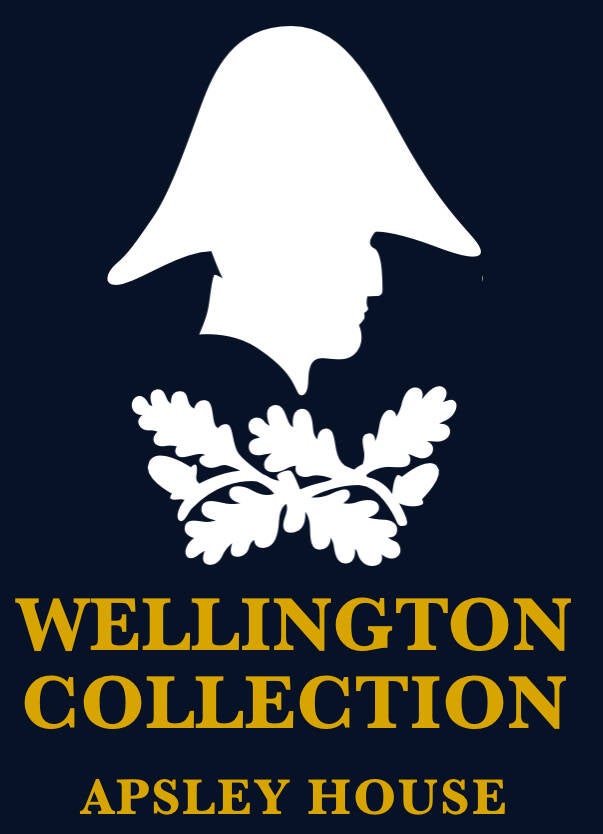




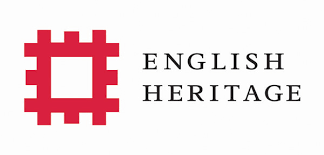
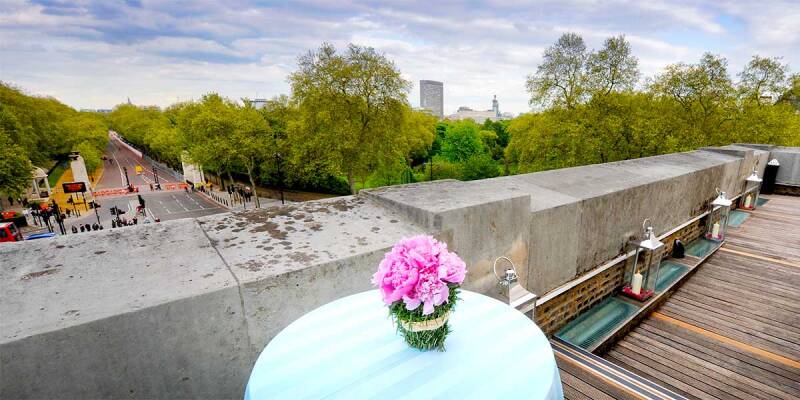
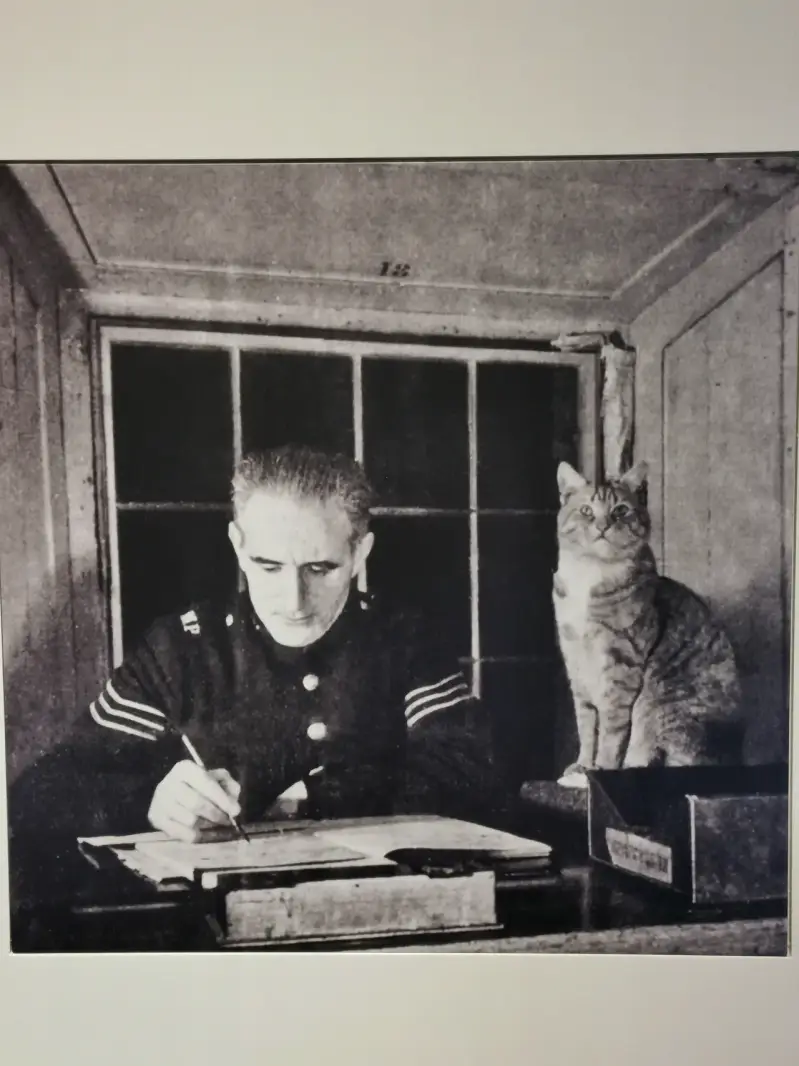




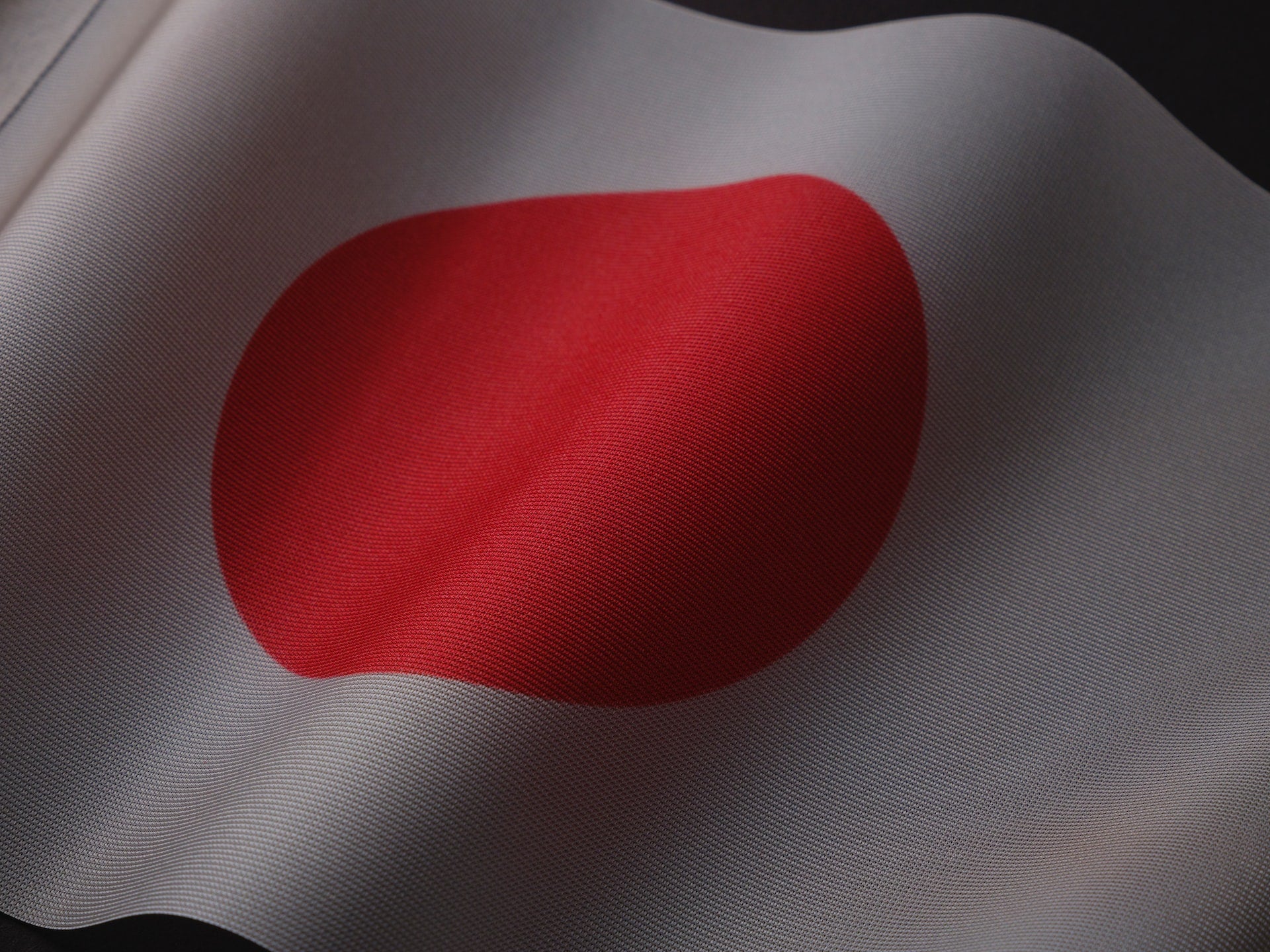

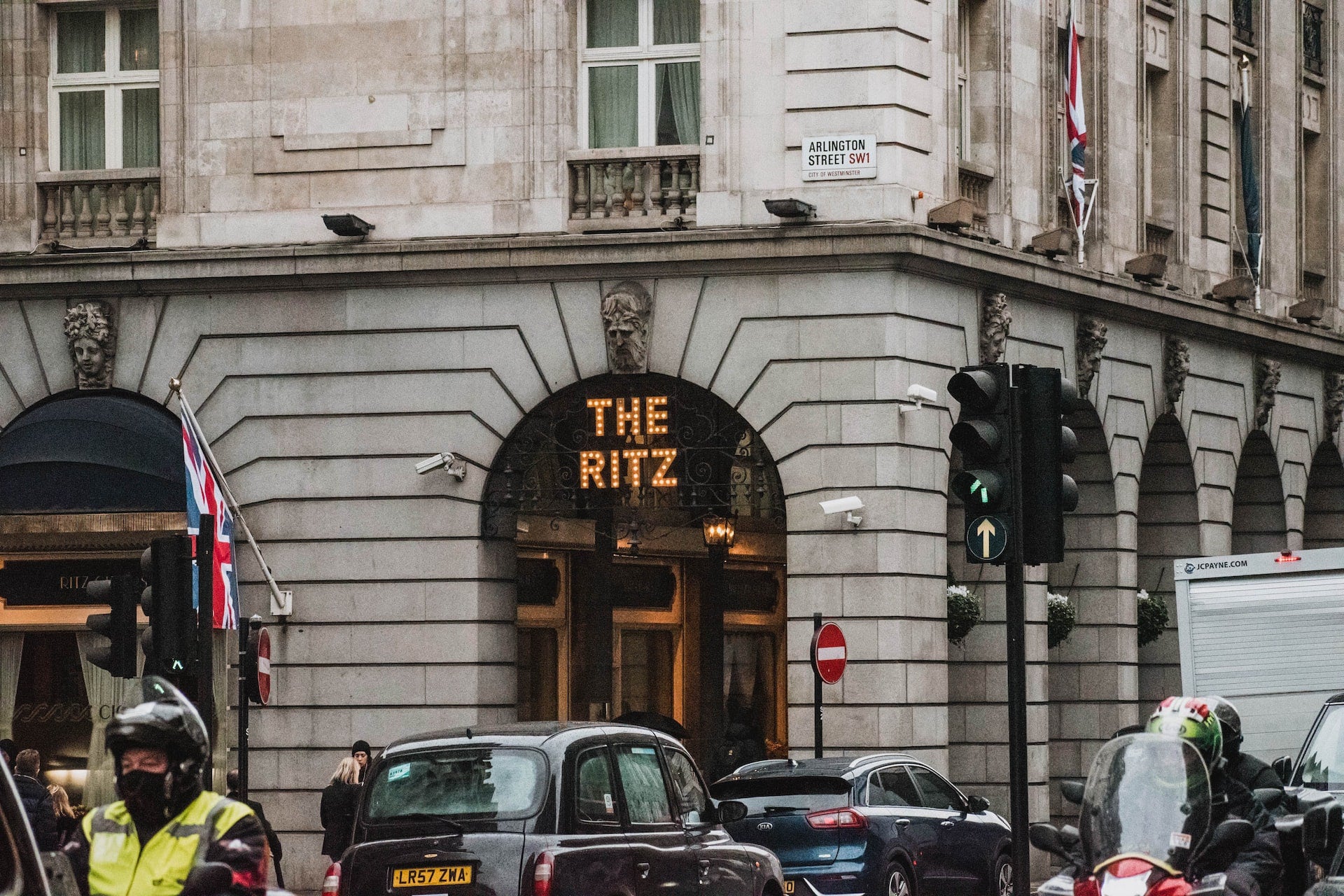



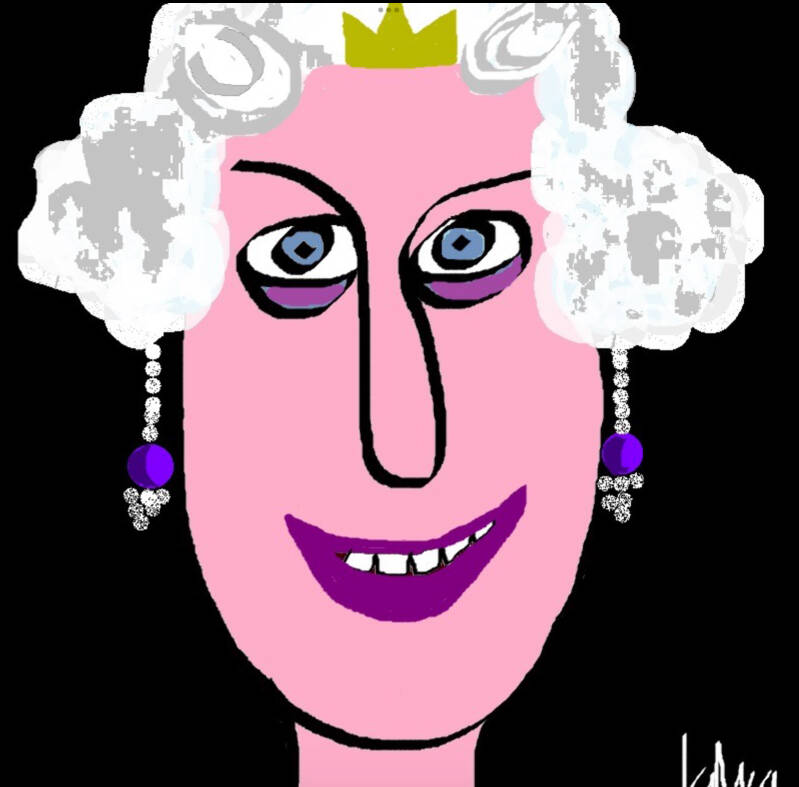
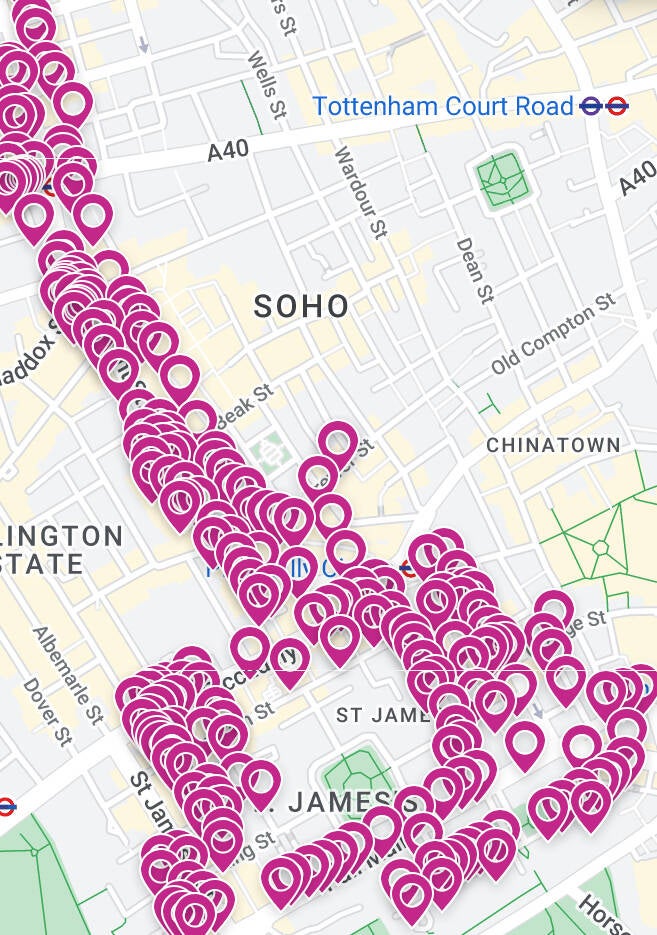

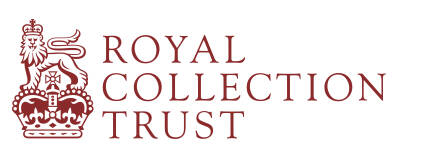
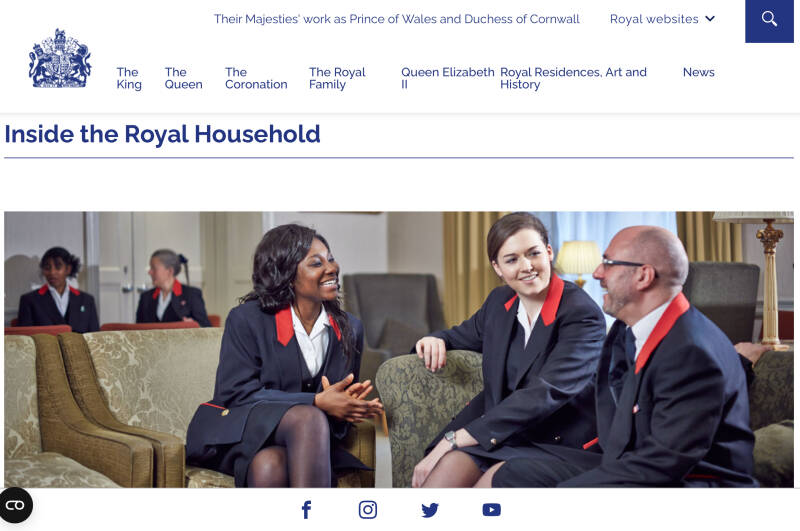

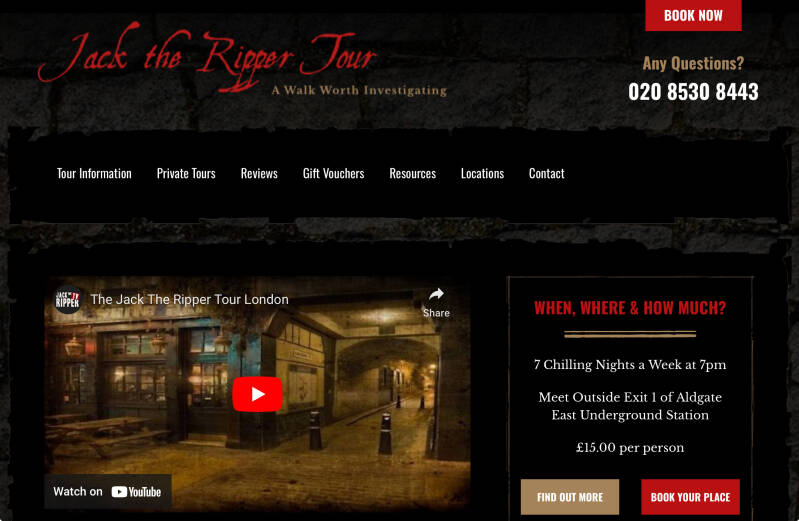
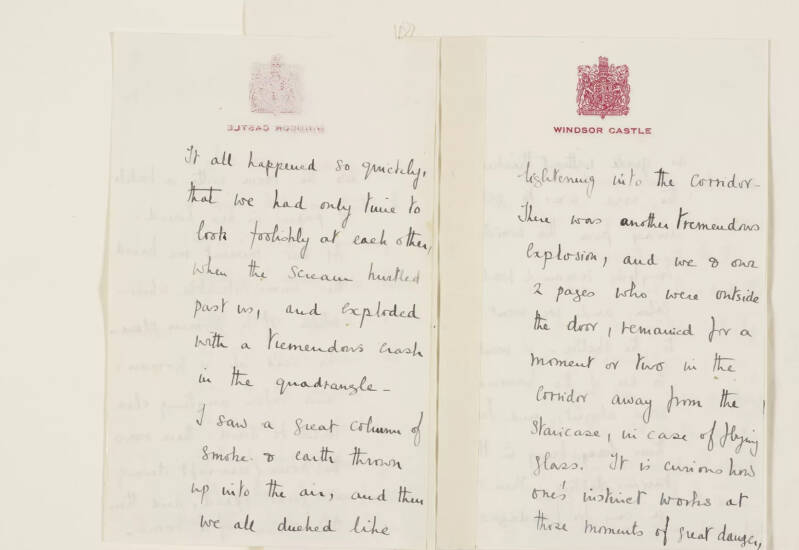

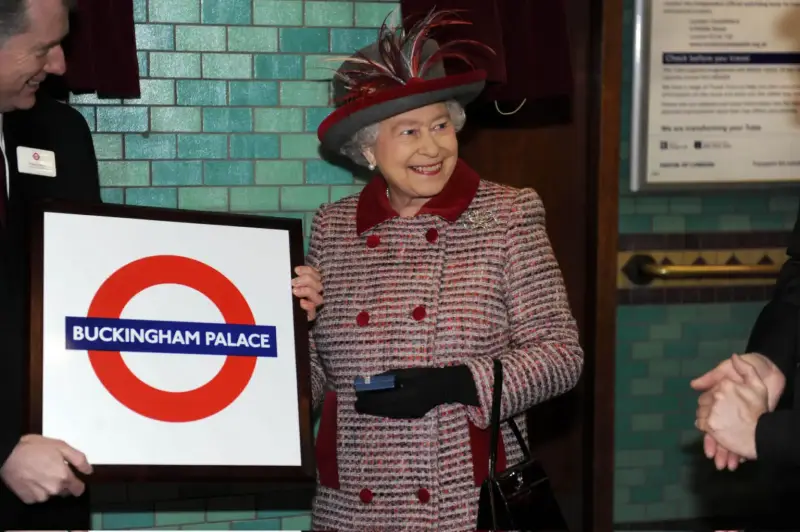
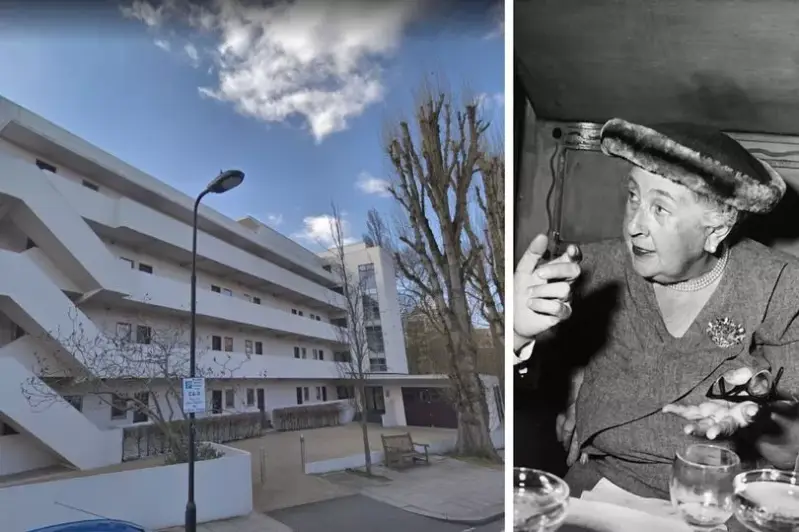
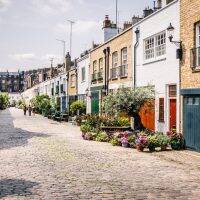


Create Your Own Website With Webador